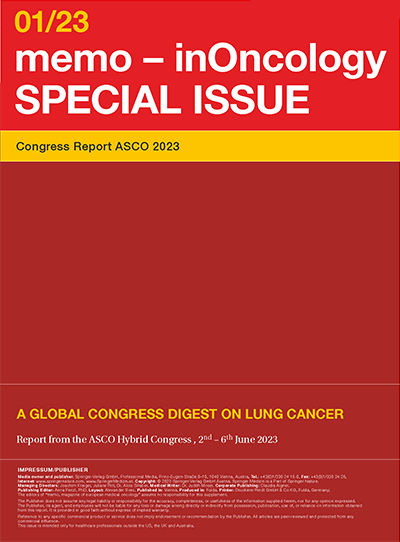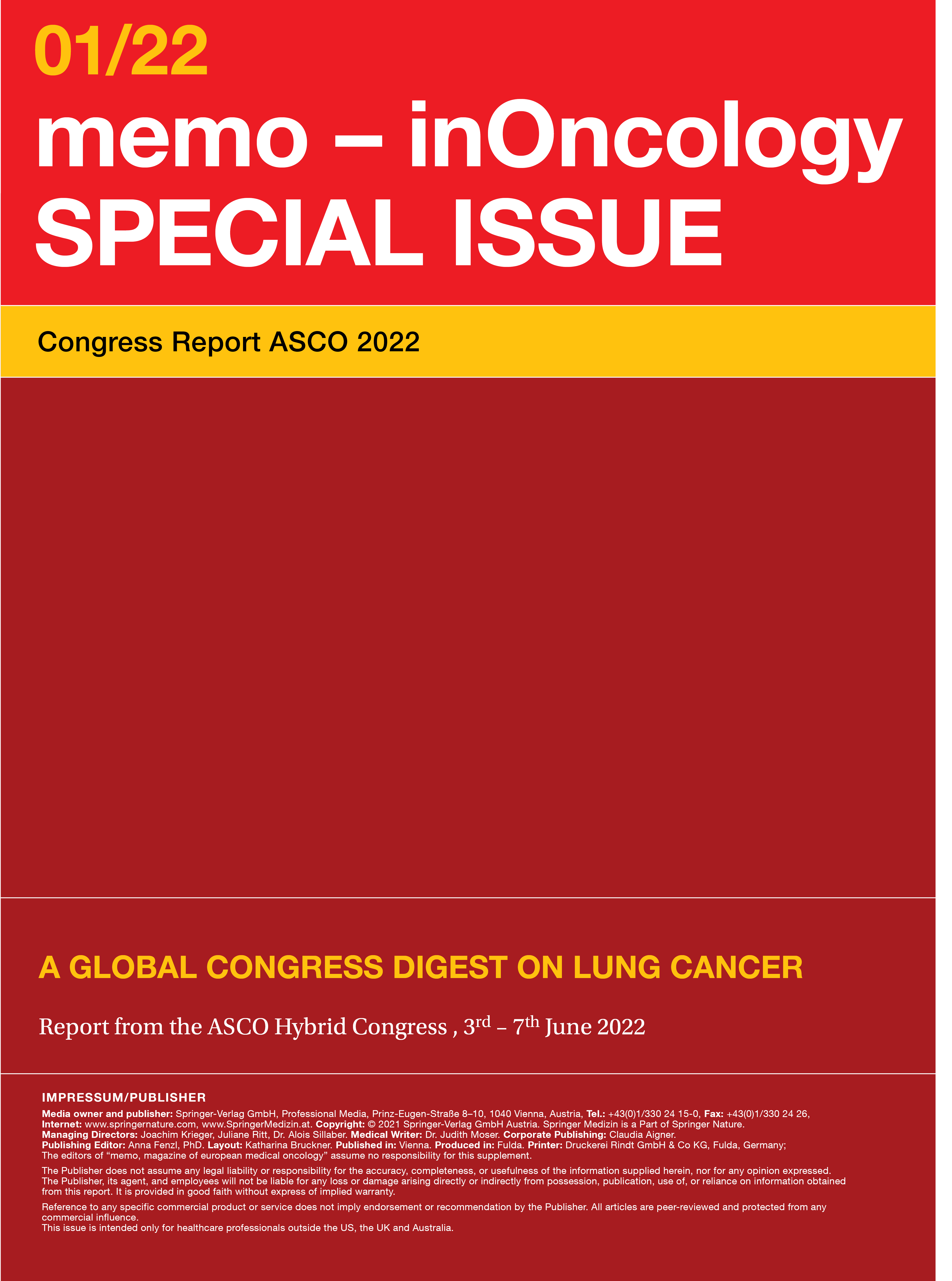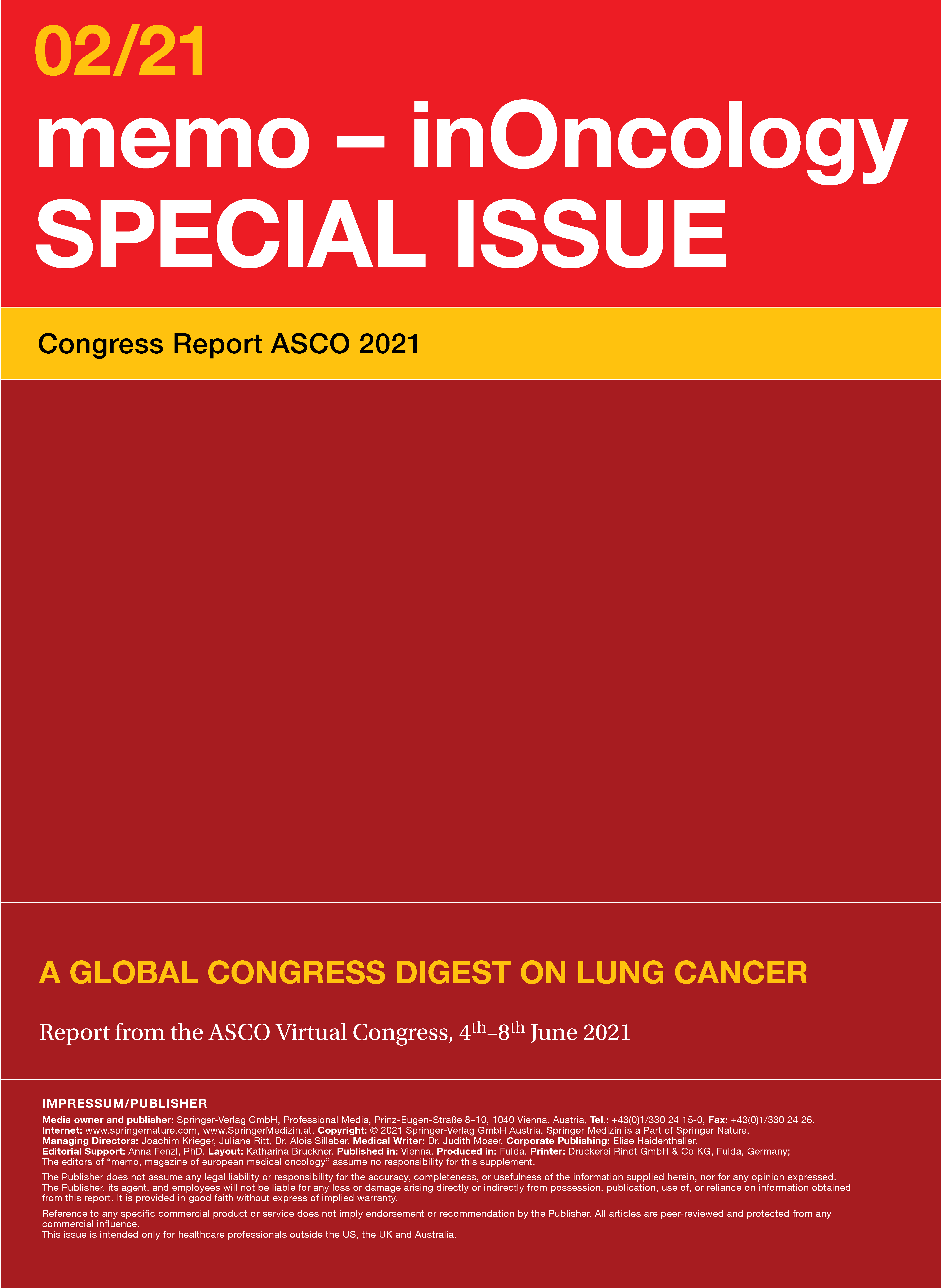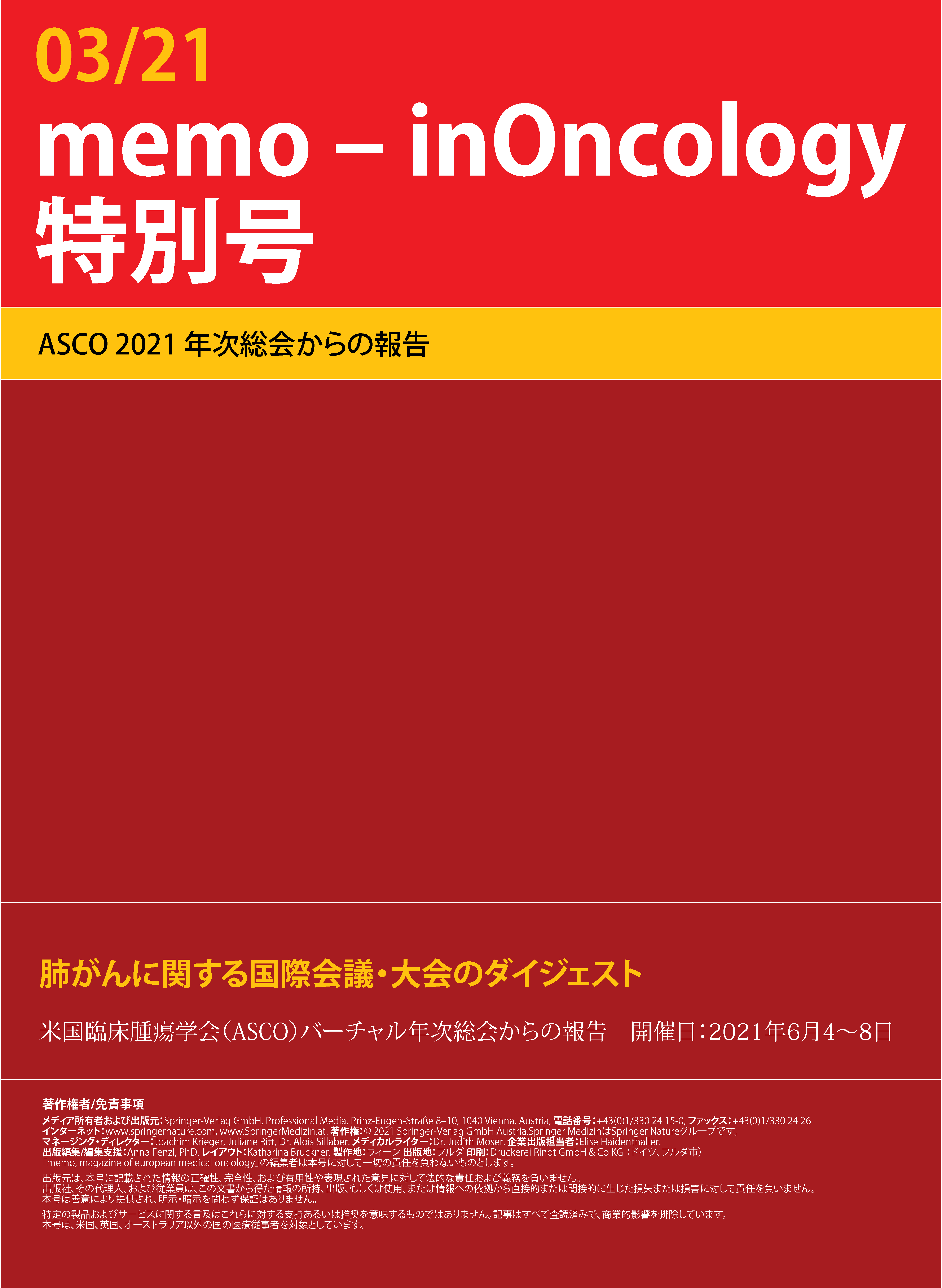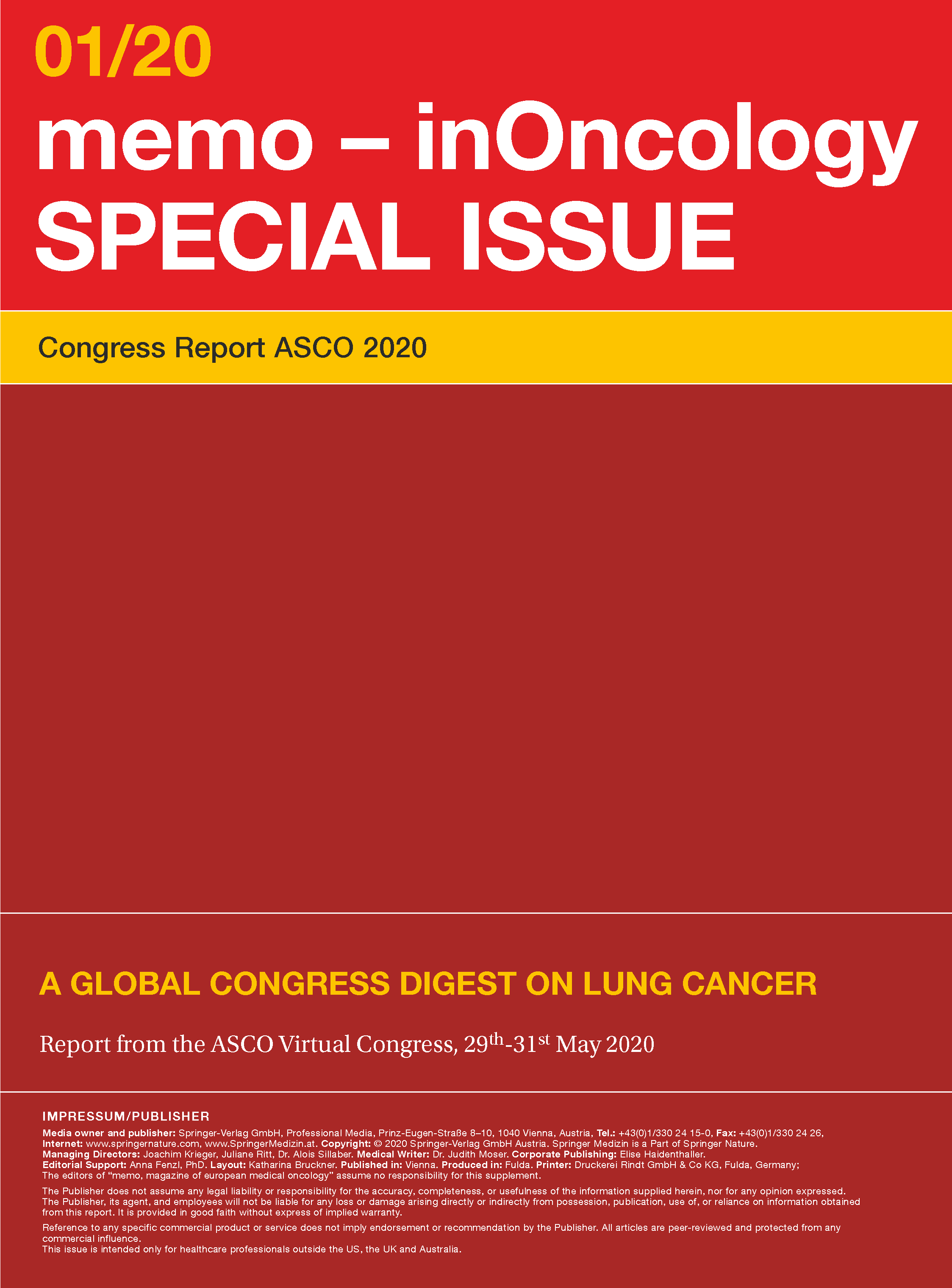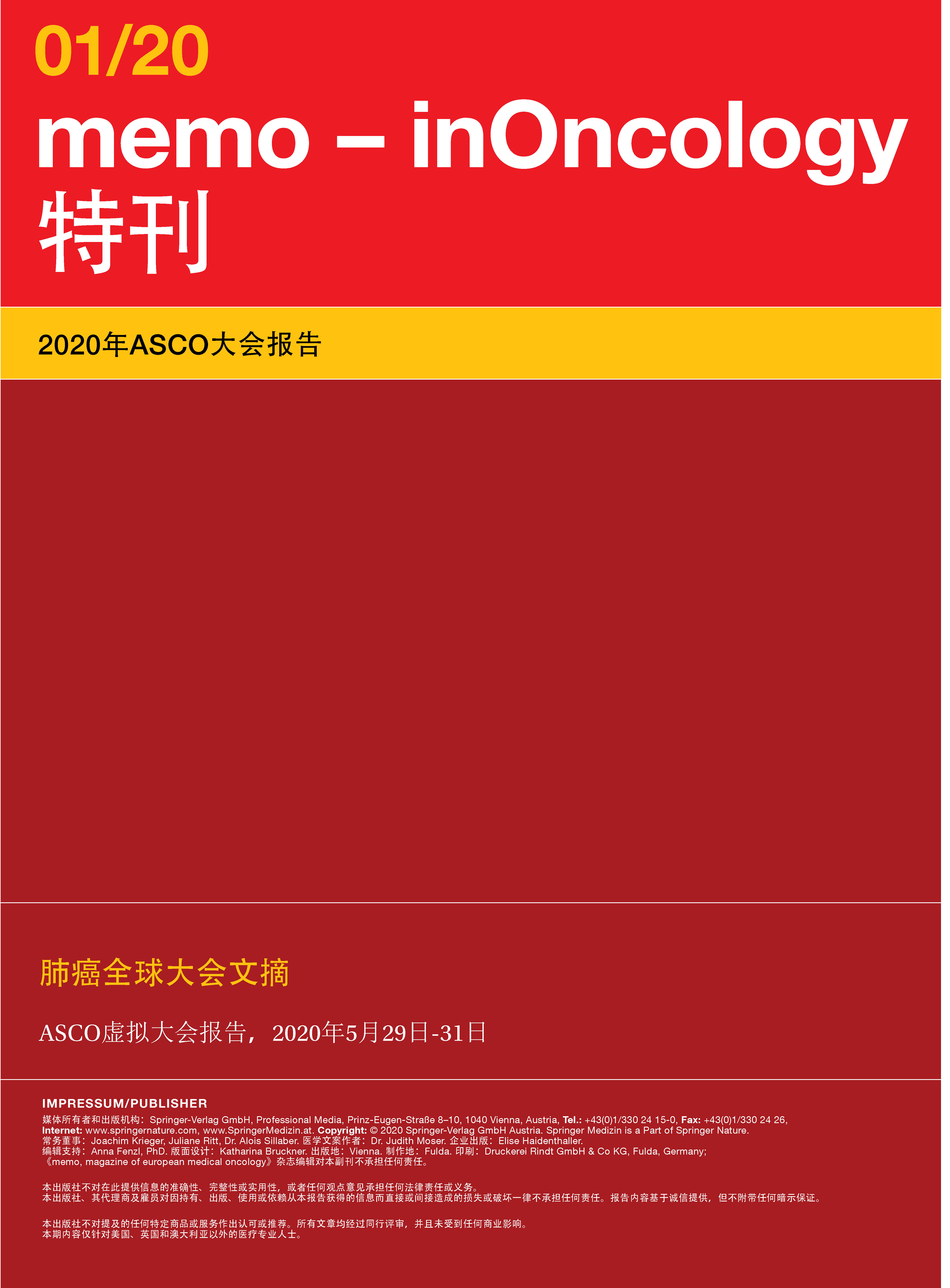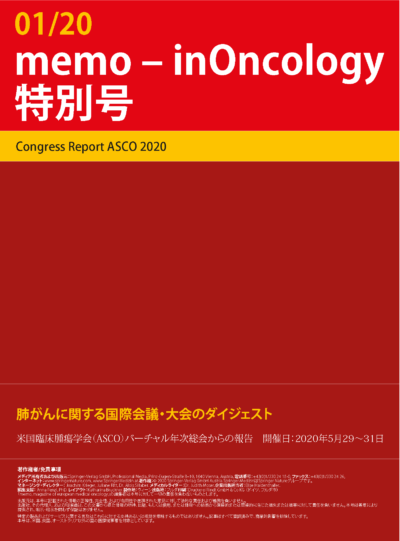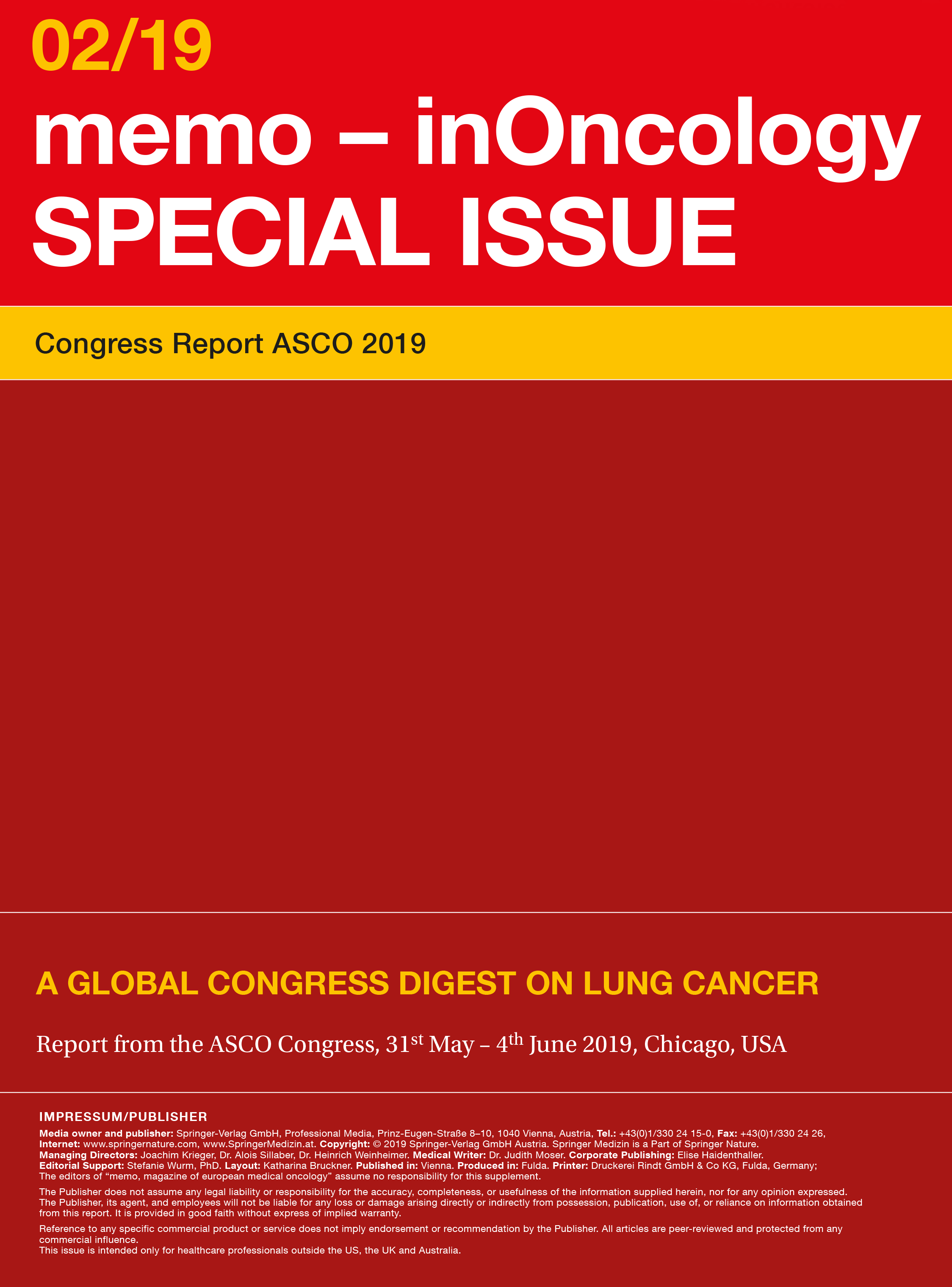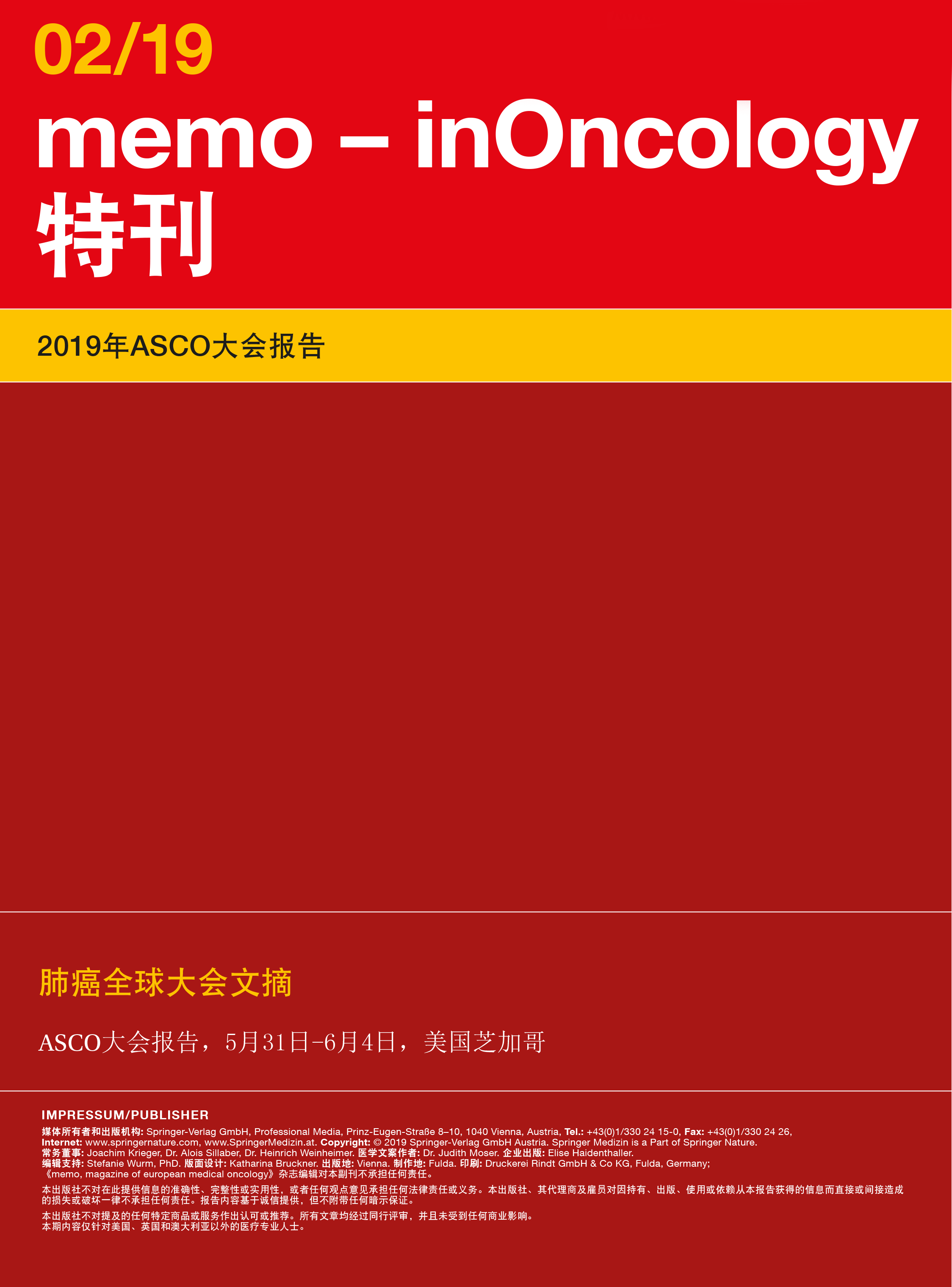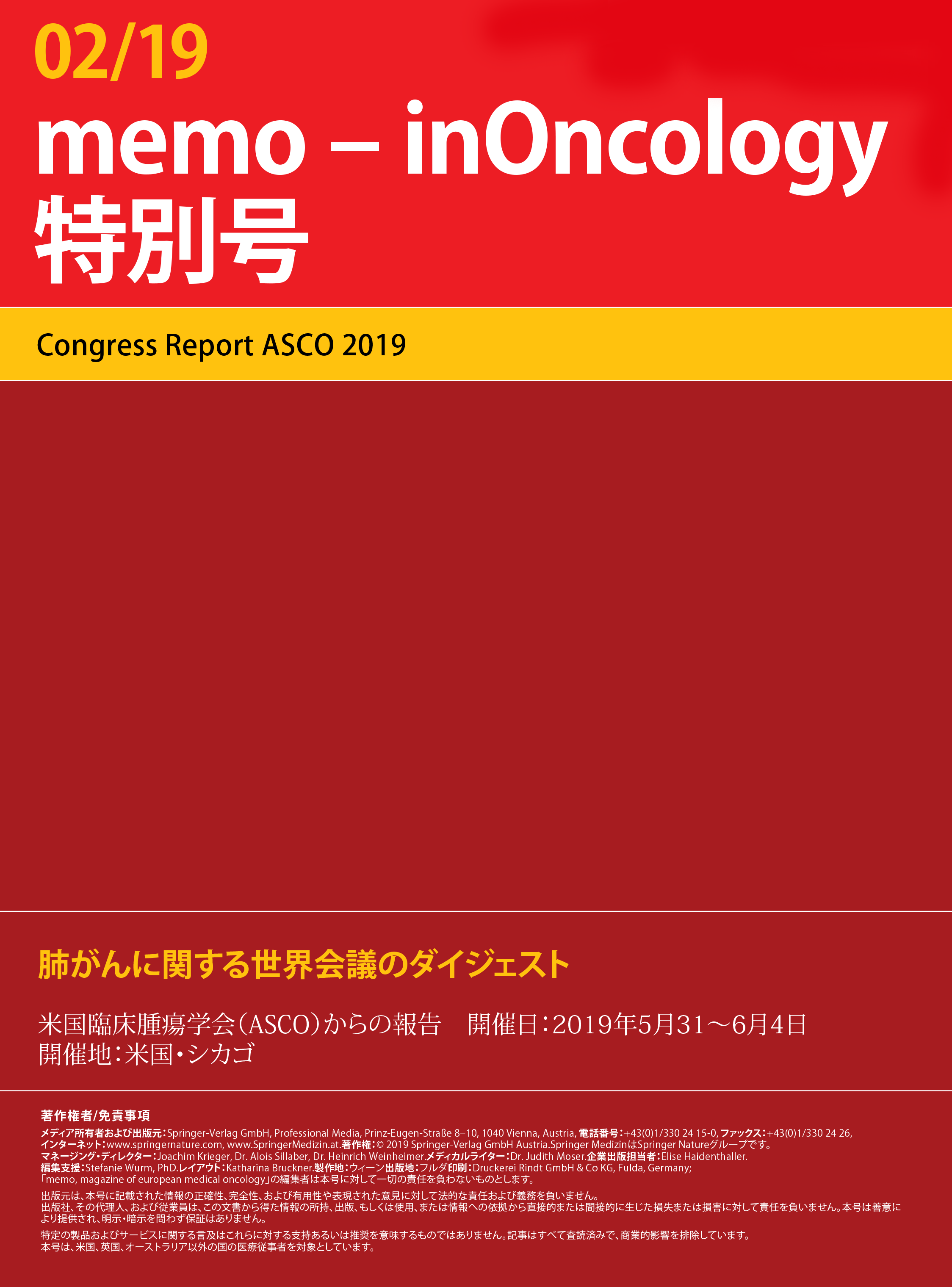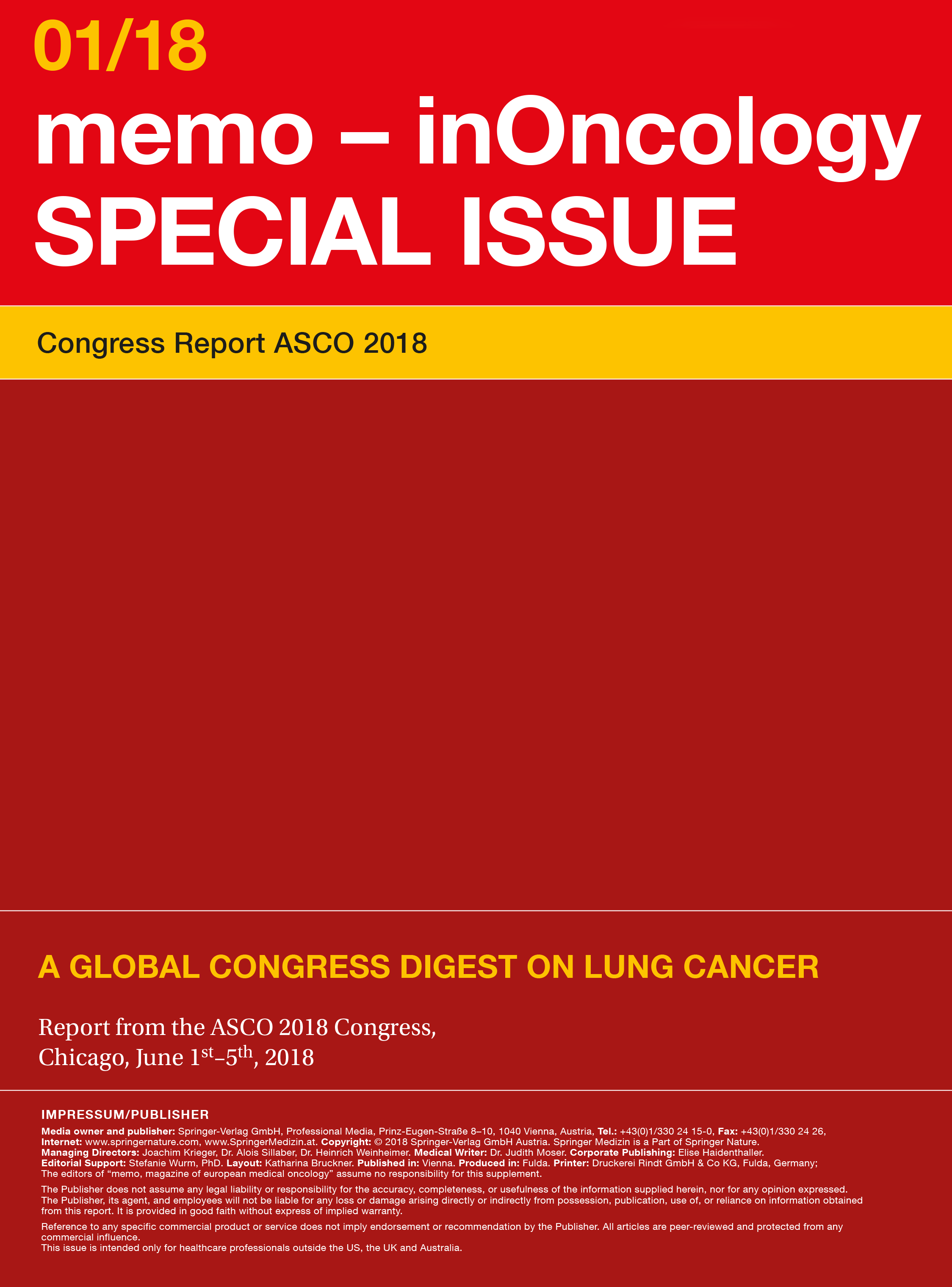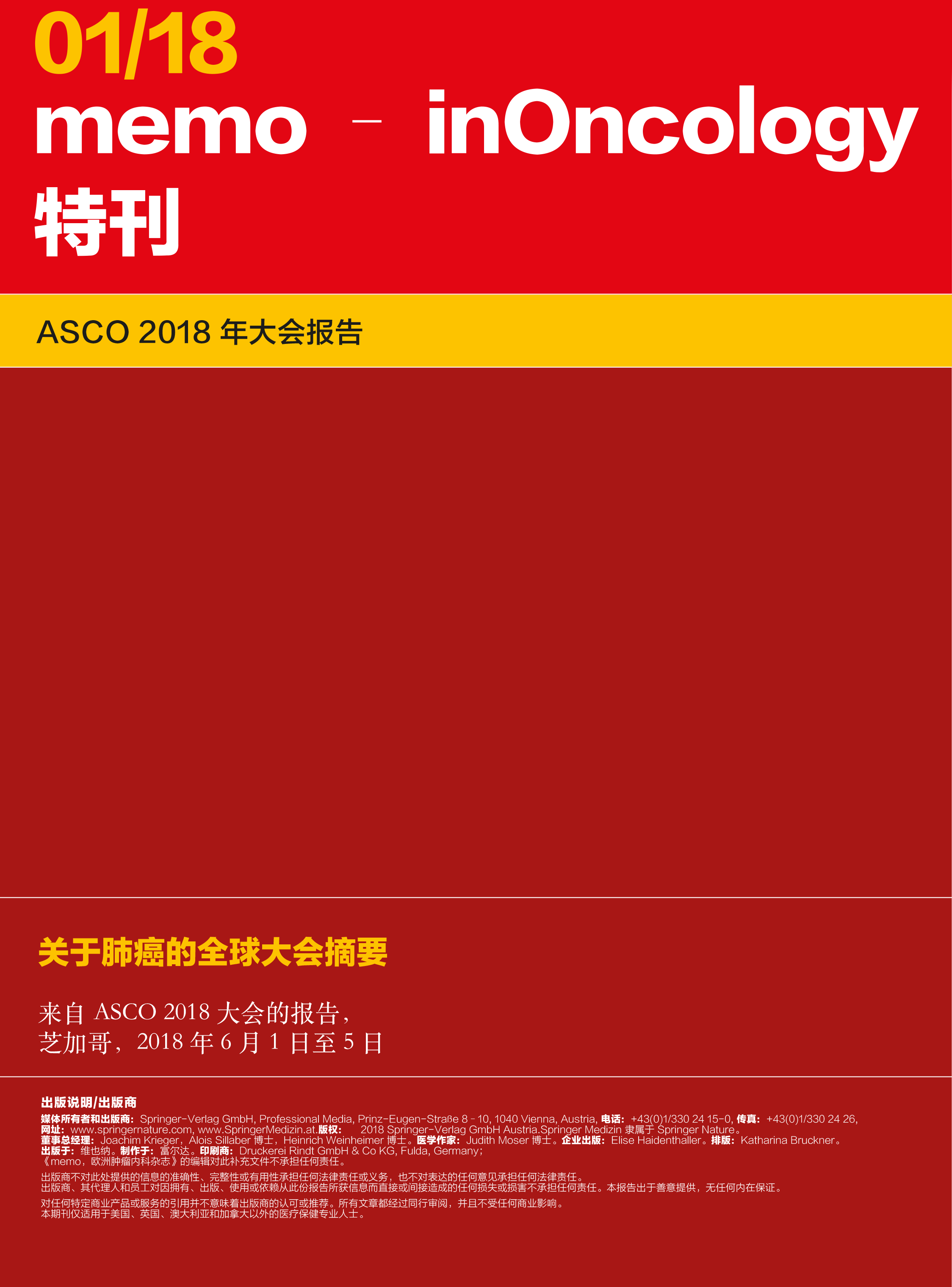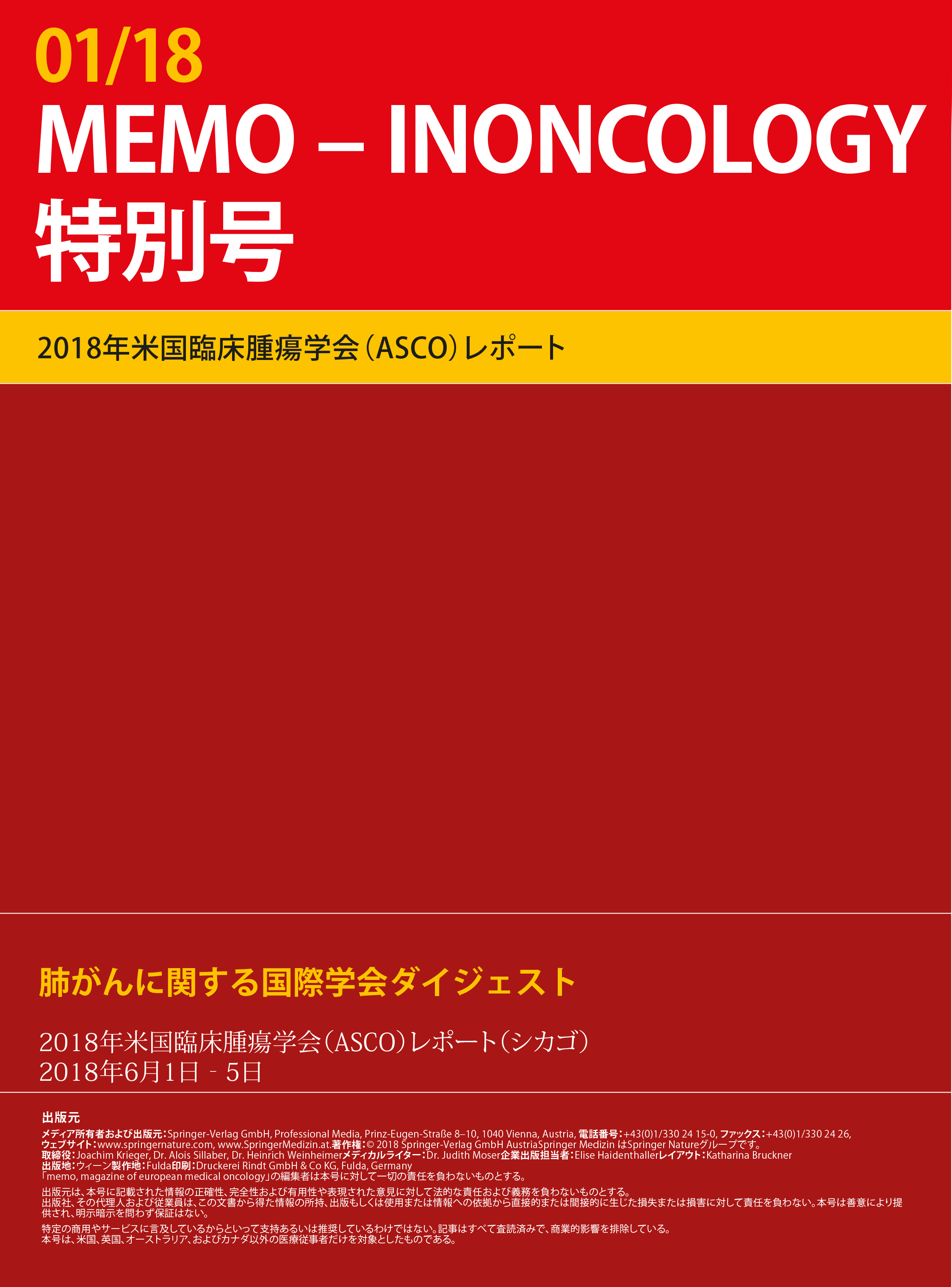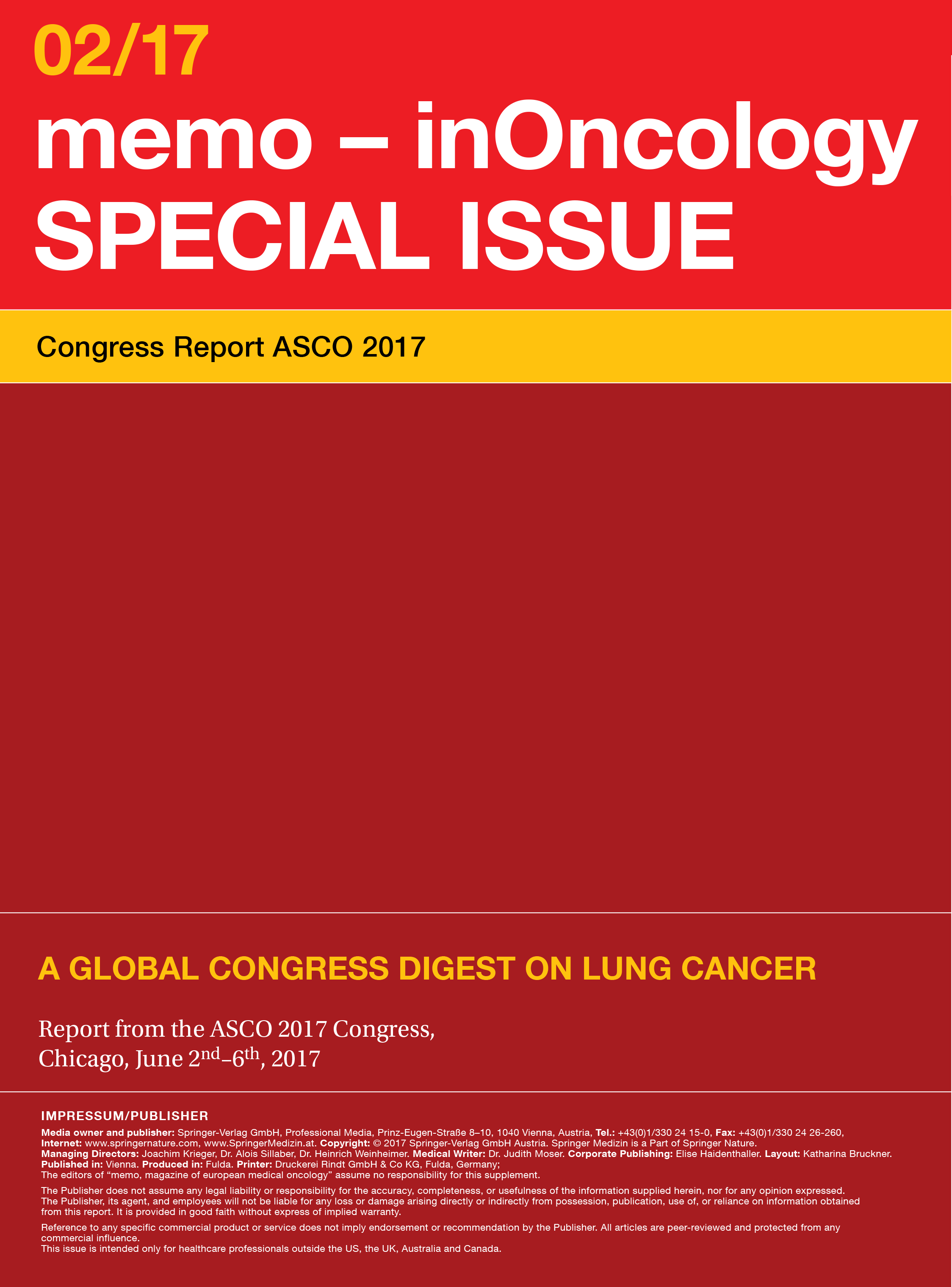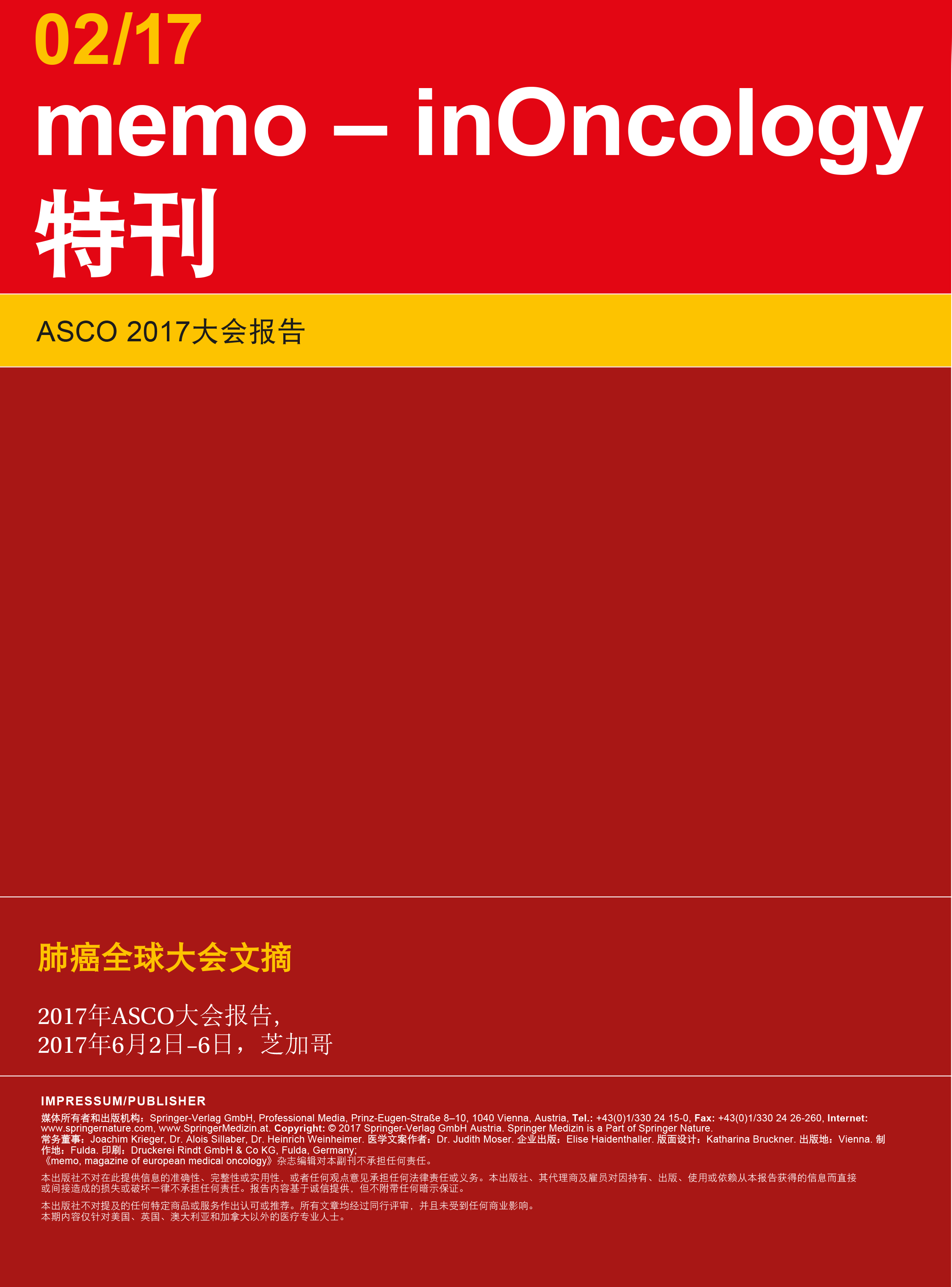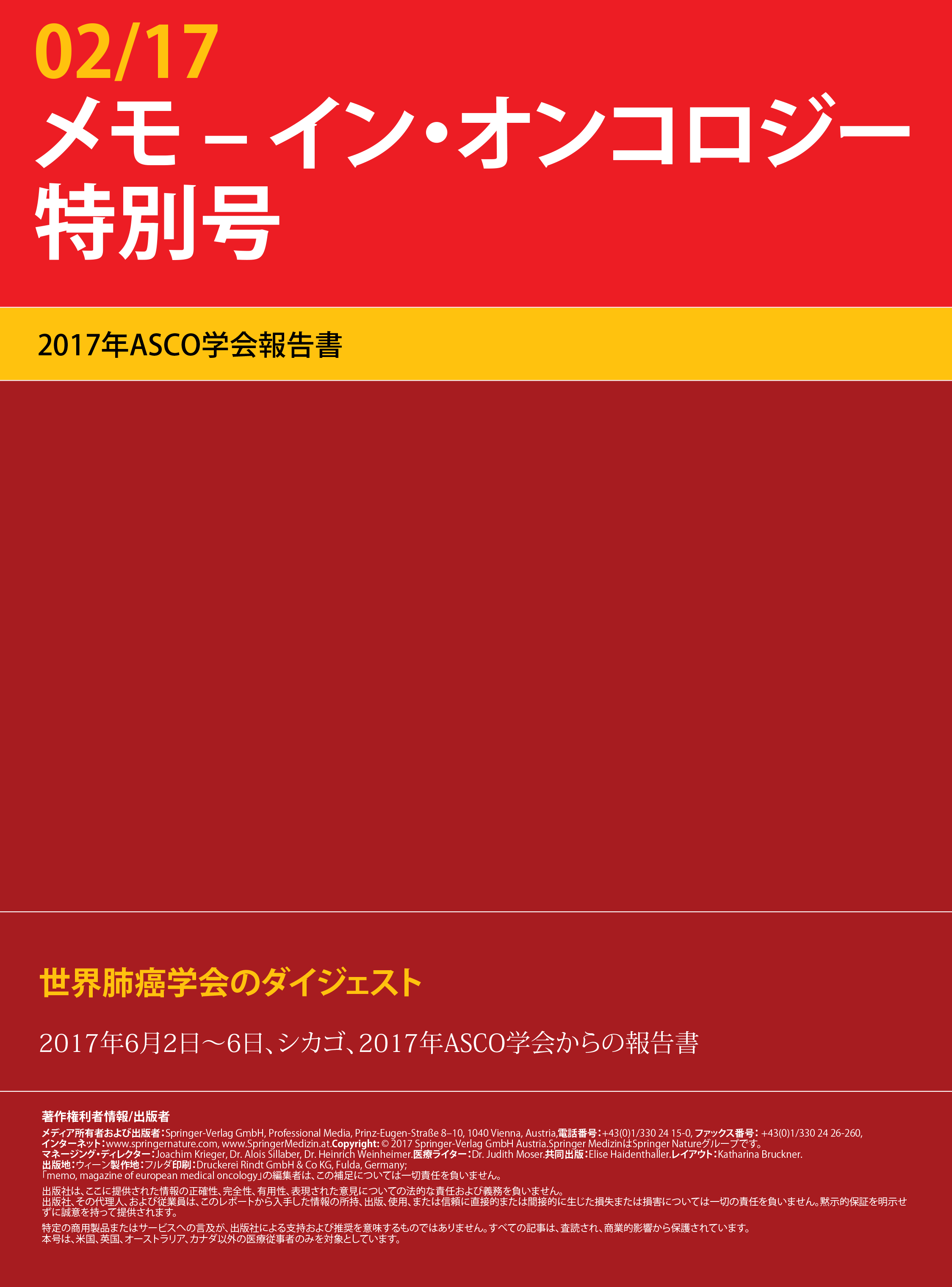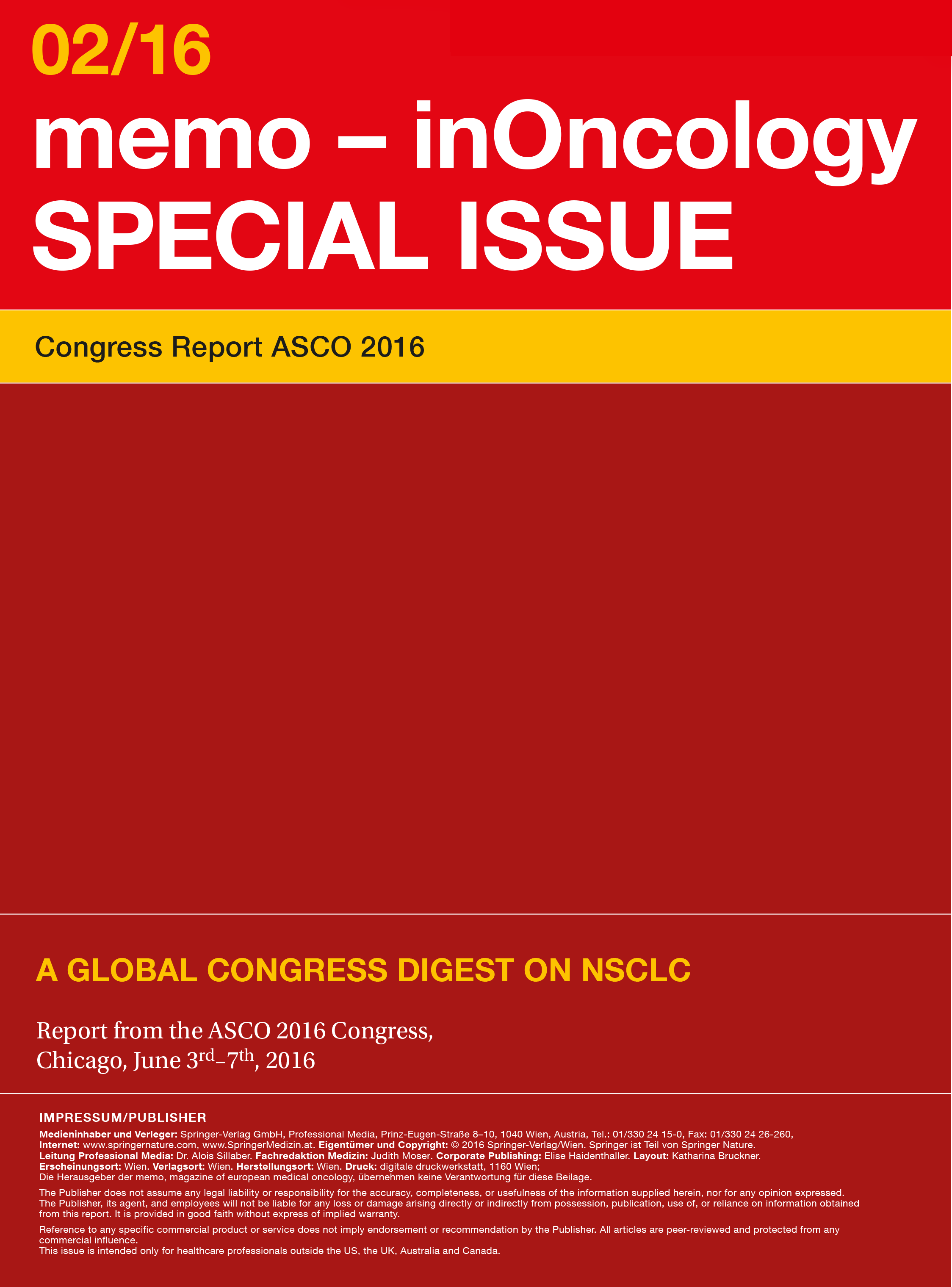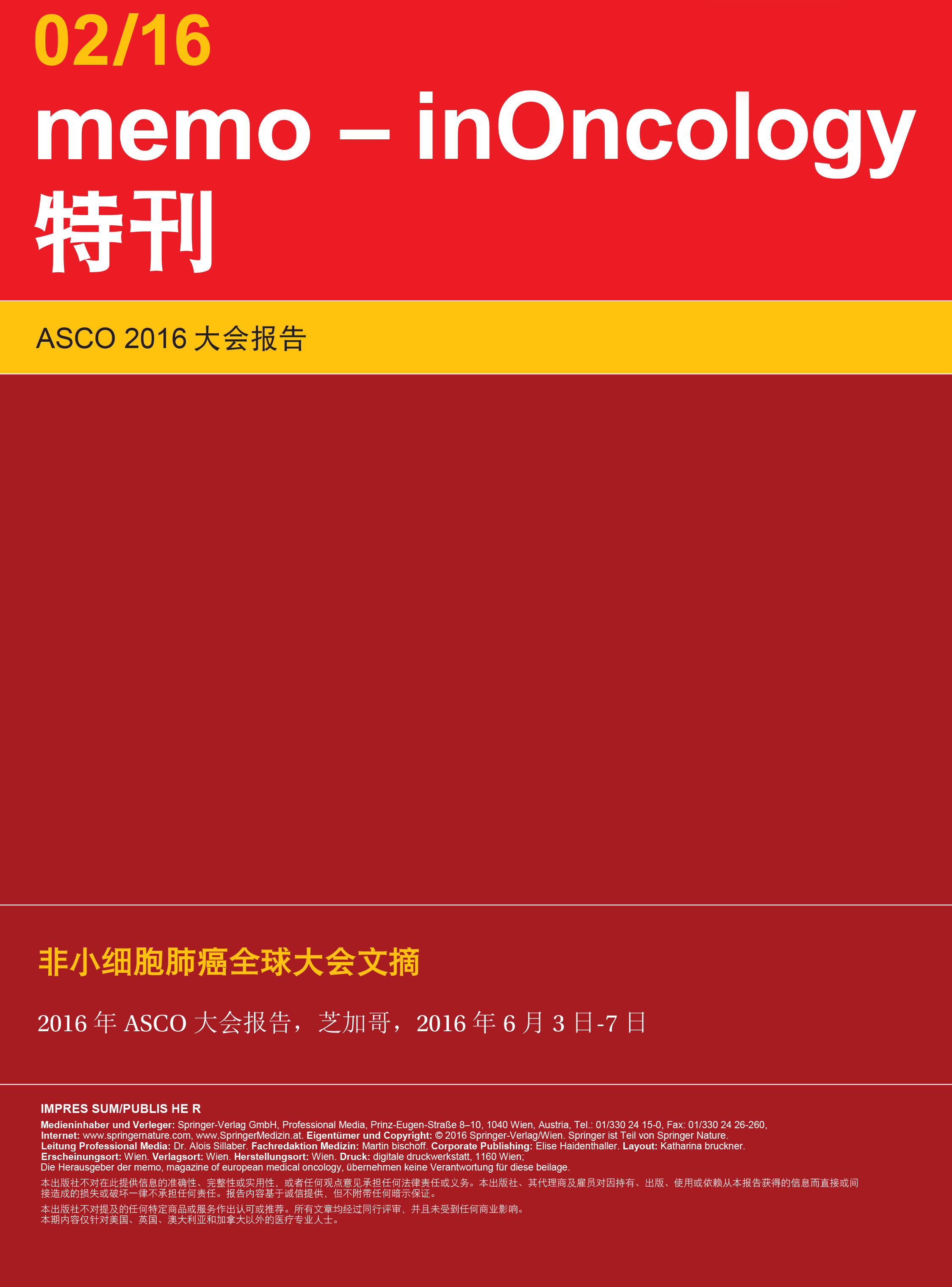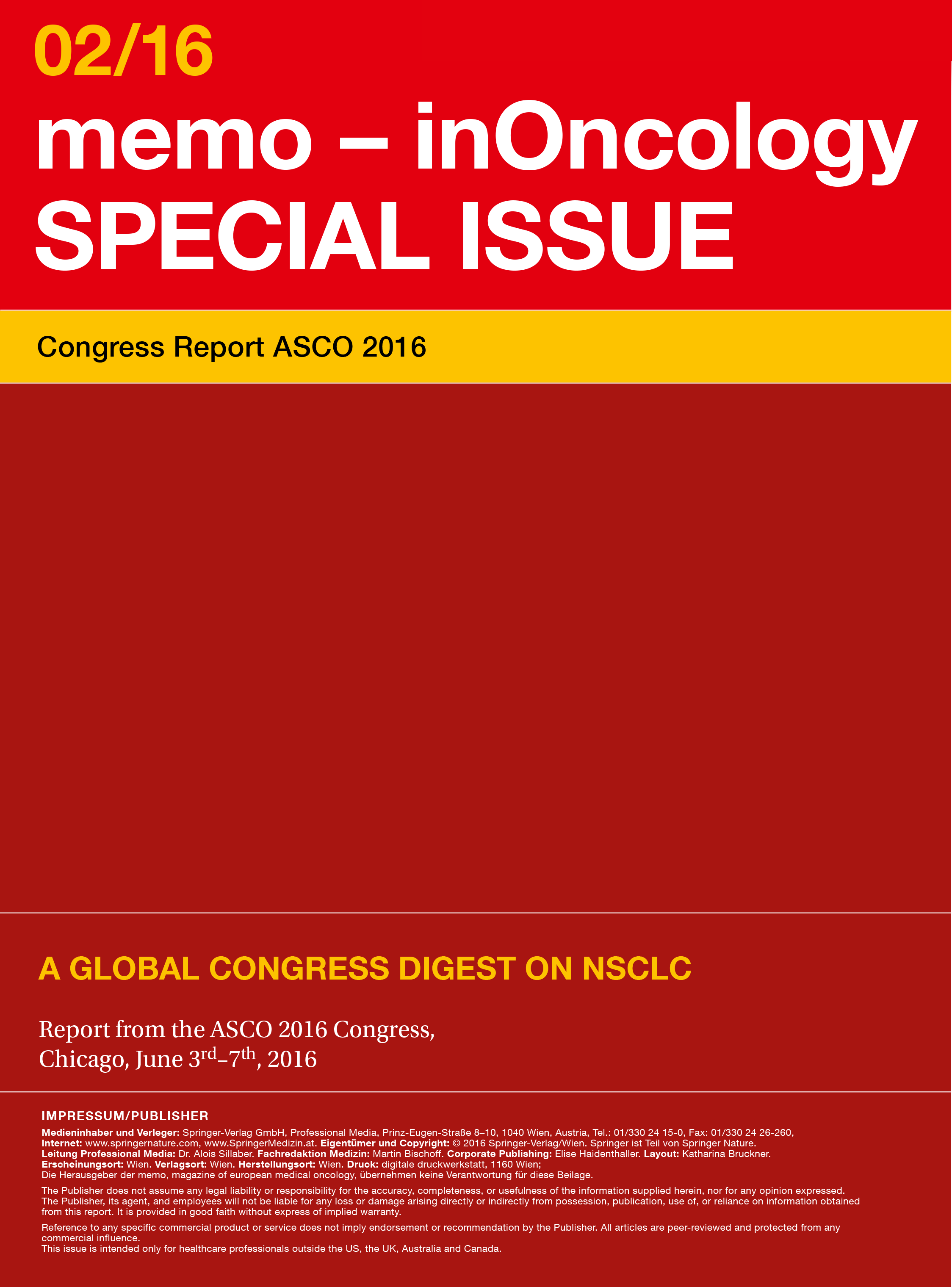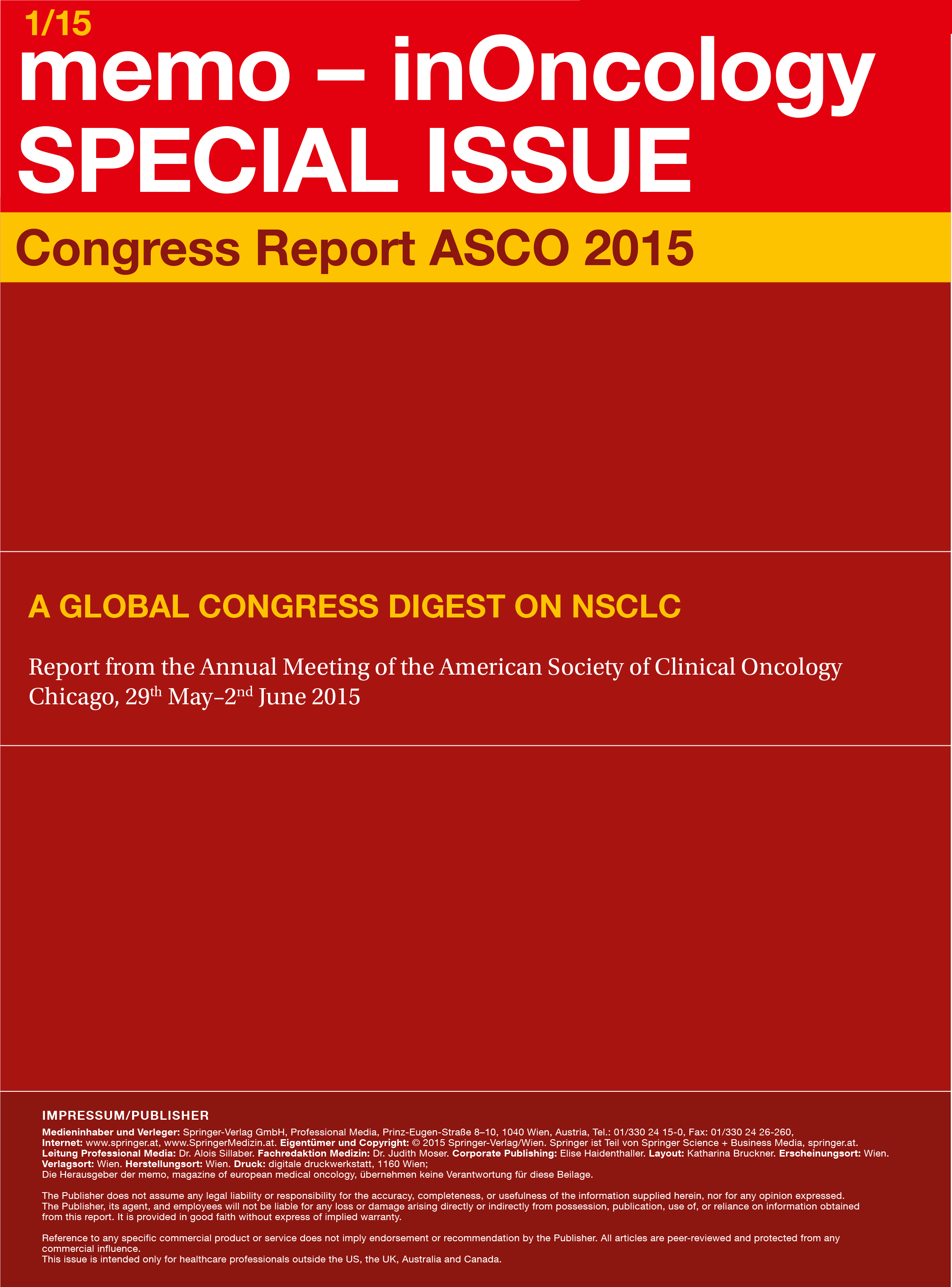ASCO Lung Cancer 2023 – hybrid, Chicago
Lecture Board: Maximilian Hochmair, MD
Medical Writer: Judith Moser, MD
Publishing Editor: Anna Fenzl, PhD
Preface – ASCO Lung Cancer 2023
Preface – ASCO Lung Cancer 2023 © private – Manali I. Patel, MD MPH MS, Associate Professor, Division of Oncology, Stanford University, School of Medicine, Staff Oncologist, Veterans Administration Palo Alto Health Care System Partnerships to Advance Cancer Care Dear Colleagues, under this year’s motto “partnering with patients: the cornerstone of cancer care and research”, oncology experts from around the world gathered at the Annual Meeting of the American Society of Clinical Oncolog
Early-stage NSCLC: current insights into perioperative strategies
Early-stage NSCLC: current insights into perioperative strategies Overall survival superiority in ADAURA The randomized phase III ADAURA study was conducted in response to the unmet need of improving 5-year overall survival (OS) rates in patients with completely resected EGFR-mutated, stage IB-IIIA non-small cell lung cancer (NSCLC), which are estimated to range between 45 % and 85 % [1-3]. In ADAURA, 682 patients after complete resection of stage IB, II, or IIIA NSCLC with or without adjuva
Small-cell lung cancer: novel agents & biomarkers
Small-cell lung cancer: novel agents & biomarkers Atezolizumab plus talazoparib as maintenance As is known, patients with extensive-stage small-cell lung cancer (ES-SCLC) tend to respond well to systemic induction therapy but frequently experience rapid disease progression. Subsequent treatment success remains a challenge; therefore, improving outcomes in the first line appears critical. Poly (ADP-ribose) polymerase (PARP) 1 has emerged as a potential therapeutic target in neuroendocrin
Targeted approaches in advanced disease
Targeted approaches in advanced disease Anti-EGFR agents plus inserted chemotherapy Acquired resistance to EGFR tyrosine kinase inhibitors (TKIs), even including the third-generation agent osimertinib, limits duration of response and survival in treated patients with EGFR-mutant lung tumors. A potential strategy to improve outcomes is the concomitant use of EGFR-targeted agents and platinum doublet chemotherapy [1, 2], although EGFR TKI treatment might attenuate the effect of cytotoxic agent
Stage IV lung cancer: miscellaneous treatment strategies
Stage IV lung cancer: miscellaneous treatment strategies Portable antimitotic fields Considering the need for new, well tolerated and effective treatments to improve survival in metastatic NSCLC after platinum-based chemotherapy, Tumor Treating Fields (TTFields) therapy represents an innovative option. TTFields are electric fields that exert physical forces on electrically charged cellular components in dividing cancer cells, thus disrupting cell function [1, 2]. The result is an anti-mitoti
EXPERT VIDEOS
All video interviews from ASCO Lung Cancer 2023
John Heymach provides an overview on the expected benefits of HER2-selective tyrosine kinase inhibitors compared to anti-HER2-antibodies while highlighting the Beamion Lung 1 data. Moreover, he talks about RET inhibitor sensitivity and resistance in lung cancer and shares which study, presented at this year’s ASCO congress, is most likely to impact standard of care treatment in NSCLC.
Marjorie G. Zauderer explains the correlations between histopathological features and genetics in the setting of malignant mesothelioma, and the potential benefit of studying therapeutically relevant subgroups of patients separately, critically discusses trails using PD-1 checkpoint inhibition in unresectable mesothelioma and once again encourages everyone to explore the poster sessions at the major conferences to interact with colleagues around the world.
ASCO Lung Cancer 2022 – hybrid, Chicago
Lecture Board: Maximilian Hochmair, MD
Medical Writer: Judith Moser, MD
Publishing Editor: Anna Fenzl, PhD
Preface ASCO Lung Cancer 2022
Preface – ASCO Lung Cancer 2022 Stephen V. Liu, MD, Director of Thoracic Oncology and Head of Developmental Therapeutics, Lombardi Comprehensive Cancer Center, Georgetown University Washington DC, USA Dear Colleagues, After 2 years of virtual meetings in the midst of the COVID-19 pandemic, the Annual Meeting of the American Society of Clinical Oncology (ASCO) returned to its live format, as oncology experts from around the world gathered again in Chicago, USA, and virtually fro
Early-stage NSCLC: perioperative strategies and approaches in the unresectable
Early-stage NSCLC: perioperative strategies and approaches in the unresectable Neoadjuvant chemotherapy has been shown to significantly prolong overall survival (OS) in resectable non–small-cell lung cancer (NSCLC), although the absolute 5-year survival is improved by as little as 5 % [1].
Targeting KRASG12C, METex14, EGFR & ALK: new ways to further improve patient outcomes
Targeting KRASG12C, METex14, EGFR & ALK: new ways to further improve patient outcomes KRYSTAL-1: adagrasib in KRASG12C-mutated tumors KRASG12C mutations are found in approximately 14 % of patients with adenocarcinoma of the lung [1].
Deeper insights into combinations of immune checkpoint inhibitors with other drug classes
Deeper insights into combinations of immune checkpoint inhibitors with other drug classes Pooled data on chemo-IO vs. IO in PD-L1 ≥ 50 % Various regimens consisting of anti-PD-(L)1 antibodies with or without chemotherapy have been approved for the first-line treatment of patients with advanced NSCLC that does not harbor genomic alterations.
Extensive-stage small-cell lung cancer: successful and less successful combination strategies
Extensive-stage small-cell lung cancer: successful and less successful combination strategies In the first-line treatment of patients with extensive-stage small cell lung cancer (ES-SCLC), the IMpower133 and CASPIAN trials have established the anti-PD-L1 antibodies atezolizumab and durvalumab, respectively, as standard-of-care treatment in addition to platinum-etoposide [1-3].
The clinical care pathways in early-stage lung cancer are changing
The clinical care pathways in early-stage lung cancer are changing Jessica Donington, MD, MSCR, Section Thoracic Surgery, The University of Chicago Medicine, Chicago, USA Which agents that are currently being investigated in the neoadjuvant setting in patients with resectable NSCLC look promising from the present point of view? Many immunotherapies are being studied in the neoadjuvant or perioperative setting, but the only one that has been reported in a phase III trial as neoadjuvan
EXPERT VIDEOS
All video interviews from ASCO Lung Cancer 2022
John Varlotto summarizes the insights that have been obtained based on recent studies regarding immunotherapy plus chemoradiation in patients with unresectable, locally advanced stage III non-small cell lung cancer, explains the different effect observed with pembrolizumab and nivolumab and how these results compare to existing data. He cautions against using the impressive pathologic complete response rates with neoadjuvant chemoimmunotherapy to the unresectable setting due to the lack of long-term survival rates with neo-adjuvant chemo/immunotherapy and the impressive 47.5 median overall survival noted with concurrent chemo/radiotherapy followed by consolidative durvalumab in the Pacific Trial.
Jessica Donington highlights the most promising agents currently investigated in the neoadjuvant setting in patients with resectable NSCLC, how the “intensity” of neoadjuvant treatment affects the outcomes and discusses if neoadjuvant chemo-immunotherapy is the new standard of care. She outlines which variables related to surgery itself are determinants of the success of curative surgery and which biomarkers are on the rise to guide therapy.
ASCO Lung Cancer 2021 – virtual
Lecture Board: Maximilian Hochmair, MD; Donald Harvey, PharmD; Martin Reck, MD, PhD
Medical Writer: Judith Moser, MD
Publishing Editor: Anna Fenzl, PhD
Preface ASCO 2021
Preface ASCO 2021 Martin Reck, MD, PhD Department of Thoracic Oncology Airway Research Center North, German Center of Lung Research Lung Clinic Grosshansdorf Grosshansdorf, Germany Dear Colleagues, As in 2020, the 2021 Annual Meeting of the American Society of Clinical Oncology (ASCO) was held online, with both the scientific and education programs taking place on June 4-8.
Early-stage lung cancer: immunotherapeutic standards
Early-stage lung cancer: immunotherapeutic standards IMpower010: adjuvant administration of atezolizumab Despite established strategies such as platinum-based chemotherapy and EGFR-targeted agents, there is a high unmet need for improved adjuvant treatment in the setting of completely resected early-stage NSCLC (stage IB-IIIA).
EGFR-mutant disease: strategies against sensitizing and resistance-mediating mutations
EGFR-mutant disease: strategies against sensitizing and resistance-mediating mutations Targeting HER3: patritumab deruxtecan EGFR tyrosine kinase inhibitors (TKIs) are the established first-line option in patients with EGFR-mutated NSCLC, although resistance inevitably develops in the long run.
KRAS, MET, ROS1, HER2: current perspectives
KRAS, MET, ROS1, HER2: current perspectives CodeBreaK100: sotorasib Approximately 13 % of patients with adenocarcinoma of the lung harbor the KRASG12C mutation [1].
Immunotherapy: from predictive factors to antibiotics
Immunotherapy: from predictive factors to antibiotics Update of CheckMate 9LA Based on the randomized, phase III CheckMate 9LA study, the first-line regimen of nivolumab plus ipilimumab and two cycles of chemotherapy has been approved in the indication of metastatic NSCLC without EGFR or ALK aberrations in many countries.
How does checkpoint inhibition perform in the setting of oncogene-driven lung cancer?
How does checkpoint inhibition perform in the setting of oncogene-driven lung cancer? Impact of various aberrations Retrospective analyses have demonstrated limited activity of immune checkpoint inhibitors (CPIs) in patients with actionable oncogenic driver mutations [1, 2].
Enhancing immunosupportive mechanisms via anti-angiogenesis
Enhancing immunosupportive mechanisms via anti-angiogenesis Treatment with anti-angiogenic agents offers potential in the management of patients progressing on immune checkpoint inhibitors as it has been shown that excessive VEGF production can create an immunosuppressive tumor microenvironment by modulation of immune cell function and reduction of immune cell access [1-3].
Opening up new vistas for patients with SCLC
Opening up new vistas for patients with SCLC Cisplatin vs. carboplatin in LS-SCLCConcurrent chemo-radiation with a platinum-etoposide backbone constitutes the standard of care in limited-stage small-cell lung cancer (LS-SCLC).
Resistance is all too often looming with targeted therapies
Resistance is all too often looming with targeted therapies Donald Harvey, PharmD, Emory University School of Medicine, Atlanta, USA In which ways is resistance being tackled in the setting of targeted agents? Resistance is the biggest challenge across the landscape of different compounds such as the new RET or MET inhibitors.
序言
序言 Martin Reck, MD, PhD 德国大汉斯多夫 北气道研究中心胸腔肿瘤部 德国肺病研究中心 大汉斯多夫肺癌试验中心 亲爱的同事们, 如同2020年,2021年的美国临床肿瘤学会(ASCO)年会在线召开,科学和教育项目均于6月4日至8日举行。
早期肺癌:免疫治疗标准
早期肺癌:免疫治疗标准 IMpower010:阿特珠单抗(atezolizumab)的辅助给予 尽管已经有确立的策略,例如,铂类化疗和EGFR靶向药物,但在完全切除的早期NSCLC(IB-IIIA期)条件下对改进的辅助治疗的需求仍远未得到满足。
EGFR突变型疾病:针对敏感突变和耐药性介导突变的策略
EGFR突变型疾病:针对敏感突变和耐药性介导突变的策略 靶向HER3:帕曲妥单抗-德卢替康(patritumab deruxtecan) EGFR酪氨酸激酶抑制剂(TKI)是EGFR突变型NSCLC患者的既定一线选择,但从长远来看不可避免地会产生耐药性。
KRAS、MET、ROS1、HER2:当前观点
KRAS、MET、ROS1、HER2:当前观点 CodeBreaK100:索托拉西(sotorasib) 大约13%的肺腺癌患者携带KRASG12C突变[1]。
免疫疗法:从预测因子到抗生素
免疫疗法:从预测因子到抗生素 CheckMate 9LA的更新结果 基于随机化III期CheckMate9LA研究,纳武单抗外加伊匹单抗(ipilimumab)和两个化疗周期的一线治疗方案已在许多国家被批准用于无EGFR或ALK畸变的转移性NSCLC的适应症。
检查点抑制在致癌基因驱动的肺癌中表现如何?
检查点抑制在致癌基因驱动的肺癌中表现如何? 各种畸变的影响 回顾性分析显示,免疫检查点抑制剂(CPI)在带有可操作致癌驱动突变的患者中的活性有限[1, 2]。
经由抗血管发生来增强免疫支持机制
经由抗血管发生来增强免疫支持机制 使用抗血管生成剂的治疗有潜力管控接受免疫检查点抑制剂后进展的患者,因为已经证明过量的VEGF产生可通过调节免疫细胞功能和减少免疫细胞通路来创造免疫抑制性肿瘤微环境[1-3]。
为SCLC患者开辟新路径
为SCLC患者开辟新路径 LS-SCLC中的顺铂与卡铂 采用铂-依托泊苷骨架的同步放化疗构成了局限期小细胞肺癌(LS-SCLC)的标准护理。在这里,顺铂传统上是首选的铂剂。
靶向疗法经常会出现耐药性
靶向疗法经常会出现耐药性 Donald Harvey, PharmD, 美国亚特兰大埃默里大学医学院 在靶向药剂条件下如何应对耐药性呢? 耐药性是众多不同化合物(例如新的RET或MET抑制剂)面临的最大挑战。
巻頭言
巻頭言 Martin Reck, MD, PhD 胸部腫瘍学部門 Airway Research Center North, German Center of Lung Research Lung Clinic Grosshansdorf ドイツ グロースハンスドルフ 臨床医の皆様へ 2020年に引き続き、2021年の米国臨床腫瘍学会(ASCO)年次総会もオンラインで開催され、6月4日から8日にかけて、科学プログラムと教育プログラムの両方が行われました。
早期肺がん:免疫療法の標準治療
早期肺がん:免疫療法の標準治療 IMpower010:アテゾリズマブのアジュバント投与 プラチナベースの化学療法やEGFR標的薬などの確立された戦略にもかかわらず、早期NSCLC(IB-IIIA期)の完全切除例において、改善されたアジュバント治療に対する高いアンメットニーズがある。
EGFR変異疾患:感受性変異と耐性変異に対する戦略
EGFR変異疾患:感受性変異と耐性変異に対する戦略 HER3を標的とする:パトリツマブ デルクステカン EGFRチロシンキナーゼ阻害薬(TKI)は、EGFR変異NSCLC患者の第一選択薬として確立されているが、長期的には耐性が必然的に生じうる。
KRAS、MET、ROS1、HER2:現在の見解
KRAS、MET、ROS1、HER2:現在の見解 CodeBreaK100試験:ソトラシブ 肺腺がん患者の約13%は、KRASG12C変異を有している[1]。
免疫療法:予測因子から抗生物質まで
免疫療法:予測因子から抗生物質まで CheckMate 9LA試験のアップデート ランダム化第III相CheckMate 9LA試験に基づき、EGFRまたはALK異常のない転移性NSCLCの適応症において、ニボルマブとイピリムマブを併用し、化学療法を2サイクル行うファーストラインレジメンが多くの国で承認されている。
発がん性ドライバーによる肺がんに対するチェックポイント阻害の効果
発がん性ドライバーによる肺がんに対するチェックポイント阻害の効果 さまざまな遺伝子変異の影響 後ろ向き解析では、作用可能な発がん性ドライバー変異を有する患者において、免疫チェックポイント阻害剤(CPI)の有効性は限定的であることが示されている[1, 2]。
抗血管新生による免疫支持機構の強化
抗血管新生による免疫支持機構の強化 VEGFが過剰に産生されると、免疫細胞の機能が抑制され、免疫細胞のアクセスが減少することで、免疫抑制的な腫瘍微小環境が形成されることが明らかになっているため、抗血管新生剤による治療は、免疫チェックポイント阻害剤の治療が進行している患者の管理に役立つ可能性がある[1-3]。
SCLC患者に新たな展望を開く
SCLC患者に新たな展望を開く LS-SCLCにおけるシスプラチンとカルボプラチンの比較 限局型小細胞肺がん(LS-SCLC)では、プラチナ・
標的治療には抵抗が課題となる
標的治療には抵抗が課題となる Donald Harvey, PharmD, Emory University School of Medicine, Atlanta, USA 標的薬による治療において、どのような方法で耐性に対処しているのでしょうか。 RET阻害剤やMET阻害剤など、さまざまな化合物の中で最大の課題は耐性です。
EXPERT VIDEOS
All video interviews from ASCO Lung Cancer 2021
Martin Reck compares the combination of novel immune checkpoint inhibitors with other drug classes to monotherapy in terms of efficacy and tolerability, discusses the role of biomarkers and the tumor microenvironment in terms of treatment decision and focuses on the potential predictive value of immune-related adverse events.
David T. Cooke talks about health equity and health disparities relating to lung cancer management in the western world. He explains which factors based on ethnicity are likely to affect outcomes of lung cancer patients and how health disparities might be tackled in the long run at the public health level.
Donald R. Harvey discusses lung cancer from the point of view of clinical pharmacology, targets in the area of antibody-drug conjugates, the role of proteolysis targeting chimeras (PROTACs) in the treatment landscape, highlights mechanisms of resistance to small molecule inhibitors and draws attention to clinical trial design to better meet the demands of modern drug development.
Ferdinandos Skoulidis summarizes why the development of KRASG12C targeted therapies failed in the past, relates to new developments in the field of KRASG12C inhibition especially sotorasib and discusses the impact of co-mutations on personalized anticancer therapy.
Luis G. Paz-Ares explains which notable developments are taking place in the field of small-cell lung cancer with respect to new targets and targeted agents, how chemotherapeutic standards will change in the management of patients with small-cell lung cancer and highlights the most relevant findings presented at ASCO 2021 in terms of targeted therapies.
ASCO 2020 – virtual
Lecture Board: D. Ross Camidge, MD, PhD; Maximilian Hochmair, MD
Medical Writer: Judith Moser, MD
Publishing Editor: Anna Fenzl, PhD
Preface ASCO 2020
Preface ASCO 2020 D. Ross Camidge, MD, PhD Director of Thoracic Oncology, University of Colorado, Aurora, Colorado, USA National Medical Director of the Academic Thoracic Oncology Medical Investigators Consortium (ATOMIC) Dear Colleagues, Although the COVID-19 pandemic has prevented on-site attendance of the world’s largest cancer conference this year, the experts’ avid interest in advances in their respective areas of s pecialization remains unchanged. Approximately 40,000 oncology
NSCLC with MET alterations: molecular insights and innovative treatments
NSCLC with MET alterations: molecular insights and innovative treatments Oncogenic alterations of the exon 14 of the mesenchymal-epithelial transition (MET) gene occur in 3 % to 4 % of patients with adenocarcinoma of the lung and in 2 % of those with squamous-cell lung cancer [1, 2].
Immune checkpoint inhibition: comprehensive benefits, but not devoid of risks
Immune checkpoint inhibition: comprehensive benefits, but not devoid of risks Three-year findings in CheckMate 227 First-line nivolumab plus ipilimumab (NI) was shown to significantly prolong OS compared to chemotherapy in patients with advanced NSCLC irrespective of tumor PD-L1 expression in the randomized, phase III CheckMate 227 study [1].
EGFR-mutated disease: early combinations and new approaches in exon 20 insertion-positive lung cancer
EGFR-mutated disease: early combinations and new approaches in exon 20 insertion-positive lung cancer Upfront radiation plus TKI in the oligometastatic setting Oligometastatic disease is generally defined by one to five metastatic lesions. As progression occurs most frequently in sites of the original disease, it is surmised that aggressive local treatment might prevent further dissemination.
Improving outcomes in the early-stage setting with (neo)adjuvant strategies
Improving outcomes in the early-stage setting with (neo)adjuvant strategies Approximately 30 % of NSCLC patients present with resectable disease at diagnosis [1-3].
Present and future perspectives of anti-angiogenic therapy
Present and future perspectives of anti-angiogenic therapy The oral, triple angiokinase inhibitor nintedanib has been approved in the European Union and other countries in combination with docetaxel for the treatment of advanced adenocarcinoma of the lung after first-line chemotherapy.
COVID-19 in patients with thoracic cancers: TERAVOLT
COVID-19 in patients with thoracic cancers: TERAVOLT The global consortium TERAVOLT was established to determine factors that place patients with thoracic malignancies who develop COVID-19 at risk for hospitalization and death, to elucidate the clinical course of these patients and to identify therapeutic strategies that might impact survival.
Rare mutations: HER2, RET, ALK, BRAF
Rare mutations: HER2, RET, ALK, BRAF DESTINY-Lung01: trastuzumab deruxtecan Trastuzumab deruxtecan (T-DXd) is a novel antibody-drug conjugate containing a humanized anti-HER2 monoclonal antibody linked to a topoisomerase I inhibitor exatecan derivative.
Small-cell lung cancer: moving the limits further
Small-cell lung cancer: moving the limits further High-dose irradiation proves feasible Concurrent chemotherapy and thoracic radiotherapy (TRT) have been the standard treatment for limited-stage small-cell lung cancer (SCLC) since the early 1990s, with twice-daily TRT at a dose of 45 Gy being the most commonly recommended schedule.
序言
序言 D. Ross Camidge, MD, PhD 美国科罗拉多州 奥罗拉市科罗拉多大学 胸部肿瘤学主任 学术胸部肿瘤医学研究者协会(ATOMIC)国家医学主任 亲爱的同事们, 尽管COVID-19大流行阻止了今年世界上最大的癌症会议的现场参加,但专家们对各自专业领域的进展的浓厚兴趣仍未改变。
伴有MET改变的NSCLC:分子见解和创新治疗
伴有MET改变的NSCLC:分子见解和创新治疗 间充质-上皮转化(MET)基因外显子14的致癌改变发生在3%至4%的肺腺癌患者和2%的鳞状细胞肺癌患者中[1,2]。
免疫检查点抑制:综合获益,但并非没有风险
免疫检查点抑制:综合获益,但并非没有风险 CheckMate 227中的三年发现 在随机、III期CheckMate 227研究中,无论肿瘤PD-L1表达情况如何,一线纳武单抗(nivolumab)加伊匹单抗(ipilimumab)(NI)与化疗相比显著延长晚期NSCLC患者的OS[1]。在ASCO大会上,Ramalingam等人提供了试验第1部分更新的3年疗效和安全性结果[2]。
EGFR突变疾病:外显子20插入阳性肺癌的早期组合和新方法
EGFR突变疾病:外显子20插入阳性肺癌的早期组合和新方法 寡转移条件下的先期辐射加TKI 寡转移性疾病通常由一至五个转移病灶定义。由于进展最经常发生在原发病部位,因此推测积极的局部治疗可能会阻止进一步的传播。
(新)辅助策略改善早期条件下的结果
(新)辅助策略改善早期条件下的结果 约30%的NSCLC患者在诊断时表现出可切除的疾病[1-3]。手术是早期NSCLC的主要治疗方法。
抗血管生成疗法的现状和未来展望
抗血管生成疗法的现状和未来展望 口服三联血管激酶抑制剂尼达尼布(nintedanib)已在欧盟和其他国家批准与多西他赛联用,用于治疗一线化疗后的晚期肺腺癌。它通过靶向血管内皮生长因子(VEGF)受体1-3、血小板衍生生长因子(PDGF)受体α/β和成纤维细胞生长因子(FGF)受体1-3,以及RET来发挥作用[1,2]。
患有胸部癌症的COVID-19患者:TERAVOLT
患有胸部癌症的COVID-19患者:TERAVOLT 建立全球联盟TERAVOLT的目的是确定将患上COVID-19的胸部恶性肿瘤患者置于住院和死亡风险中的因素,以便阐明这些患者的临床病程并确定可能影响生存的治疗策略。
罕见突变:HER2、RET、ALK和BRAF
罕见突变:HER2、RET、ALK和BRAF DESTINY-Lung01:曲妥珠单抗deruxtecan 曲妥珠单抗deruxtecan(T-DXd)是一种含有与拓扑异构酶I抑制剂依喜替康(exatecan)衍生物连接的人源化抗HER2单克隆抗体的新型抗体-药物偶联物。
小细胞肺癌:进一步突破极限
小细胞肺癌:进一步突破极限 高剂量辐射被证明是可行的 自1990年代初以来,并行的化疗和胸部放疗(TRT)一直是局限期小细胞肺癌(SCLC)的标准治疗方法,最常用的推荐方案是每日两次TRT,剂量为45 Gy。
巻頭言
巻頭言 D. Ross Camidge(MD, PhD) 米国コロラド州オーロラ市 コロラド大学 胸部腫瘍内科長 Academic Thoracic Oncology Medical Investigators Consortium (ATOMIC) 全国医事担当部長 臨床医の皆様へ 本年は新型コロナウイルス感染症(COVID-19)の大流行によって、この世界最大のがん学会への現地参加は阻まれたものの、それぞれの専門領域の進展に対する専門家の強い関心に変化はありません。
MET遺伝子変異陽性NSCLC:分子レベルの理解と新規治療薬
MET遺伝子変異陽性NSCLC:分子レベルの理解と新規治療薬 肺がんのなかでも腺がんの3%~4%および扁平上皮がんの2%の患者には、間葉上皮転換(MET)遺伝子のエクソン14に発がん性の変異が発生する[1,2]。
免疫チェックポイント阻害:包括的な利点はあるが、リスクがないわけではない
免疫チェックポイント阻害:包括的な利点はあるが、リスクがないわけではない CheckMate 227試験の3年間の結果 第III相ランダム化比較試験のCheckMate227試験では、腫瘍のPD-L1発現の有無に関係なく進行NSCLC患者を対象に、一次治療としてニボルマブとイピリムマブの併用(NI)を化学療法と比較したところ、全生存期間(OS)が有意に延長することが示された[1]。ASCO年次総会では、 Ramalingamらが同試験のパート1から得られた有効性と安全性に関する3年間の最新結果を発表した[2]。
EGFR遺伝子変異陽性がん:エクソン20挿入陽性の肺がんに対する早期併用療法と新たな治療法
EGFR遺伝子変異陽性がん:エクソン20挿入陽性の肺がんに対する早期併用療法と新たな治療法 少数転移に対する初期の放射線療法とTKIの併用 少数転移がんとは、一般に転移病変が1~5個とされている。進行は原発部位で起こることが最も多いため、積極的な局所治療によってさらに転移するのを防ぐことができると推測される。
早期がんの転帰を改善するための(術前)術後補助療法による戦略
早期がんの転帰を改善するための(術前)術後補助療法による戦略 NSCLC患者の約30%には、診断時に切除可能な病変が認められる [1-3]。早期NSCLCの主な治療法は手術である。切除後、II期/IIIA期の肺がん患者および選定されたIB期の患者には、シスプラチンをベースとした補助化学療法が推奨される [4]。
抗血管新生療法の現状と今後の展望
抗血管新生療法の現状と今後の展望 経口トリプルアンジオキナーゼ阻害薬のニンテダニブは、化学療法による一次治療後の進行肺腺がんに対するドセタキセルとの併用療法として、欧州連合(EU)をはじめとする国々で承認されている。
胸部がん患者にみられるCOVID-19:TERAVOLT
胸部がん患者にみられるCOVID-19:TERAVOLT 国際共同研究であるTERAVOLTは、新型コロナウイルス感染症(COVID-19)を発症した胸部悪性腫瘍患者が入院や死亡のリスクにさらされる要因を確認して、このような患者の臨床経過を明らかにし、生存に影響を与える可能性がある治療戦略を特定するために設立された。
まれな遺伝子変異:HER2、RET、ALK、BRAF
まれな遺伝子変異:HER2、RET、ALK、BRAF DESTINY-Lung01試験:トラスツズマブ デルクステカン トラスツズマブ デルクステカン(T-DXd)は、ヒト化抗HER2モノクローナル抗体をトポイソメラーゼI阻害薬のエクサテカン誘導体に連結させた新規の抗体薬物複合体である。
小細胞肺がん:限界をさらに広げる
小細胞肺がん:限界をさらに広げる 高線量照射が可能であることが証明された 化学療法と胸部放射線療法(TRT)の同時併用は、1990年代初期から限局型小細胞肺がん(SCLC)の標準治療となっており、1日2回照射、総線量45GyのTRTが最も広く推奨されている治療スケジュールである。
A range of relevant and potentially practice-changing findings was presented in the field of lung cancer. Immunotherapy and targeted-therapy strategies are now being explored either before or after surgery for early stage disease, with multiple challenges in determining what is and is not a transformative approach. (ASCO 2020)
ASCO 2019 – Chicago
Lecture Board: Rafał Dziadziuszko, MD, PhD; Enriqueta Felip, MD, PhD; Maximilian Hochmair, MD; Sanjay Popat, PhD, FRCP; Elisabeth Quoix, MD
Medical Writer: Judith Moser, MD
Preface – ASCO 2019
Preface – ASCO 2019 Elisabeth Quoix, MD Department of Pneumology, Hôpitaux Universitaires de Strasbourg, Strasbourg, France Recipient of the BJ Kennedy Award ASCO 2019
Early-stage NSCLC: promising (neo)adjuvant approaches
Early-stage NSCLC: promising (neo)adjuvant approaches The NEOSTAR trial Effective treatment options are called for in patients with resectable non-small-cell lung cancer (NSCLC), as more than half of those with stage I to III disease experience relapses [1]. Chen et al. demonstrated in their animal model that tumor PD-L1 upregulation is critical for the spread and survival of metastases [2]. Based on these considerations, several clinical trials are investigating the potential benefit
Novel first-line options and other insights in EGFR-mutant lung cancer
Novel first-line options and other insights in EGFR-mutant lung cancer RELAY: addition of ramucirumab Although treatment with EGFR TKIs is generally efficient in patients with EGFR-mutant lung cancer, resistance inevitably develops within 8 to 12 months of the initiation of therapy, leading to treatment failure. Therefore, there is an unmet need for options that extend the activity of EGFR-targeted therapies. Dual blockade of the VEGF and EGFR signaling pathways represents a potential
Trial updates and new biomarkers in the field of immunotherapy
Trial updates and new biomarkers in the field of immunotherapy Long-term findings with pembrolizumab: KEYNOTE-001 KEYNOTE-001 was the first trial to demonstrate the activity of the PD-1 inhibitor pembrolizumab in patients with treatment-naïve or previously treated advanced NSCLC [1]. Notably, in this multicohort phase IB study, pembrolizumab showed greater activity with increasing PD-L1 tumor proportion score (TPS).
Interview: Blood-based testing in ALK-positive disease
Blood-based testing in ALK-positive disease Interview: Rafał Dziadziuszko, MD, PhD, Department of Oncology and Radiotherapy, Medical University of Gdańsk, Gdańsk, Poland Rafał Dziadziuszko, MD, PhD, Department of Oncology and Radiotherapy, Medical University of Gdańsk, Gdańsk, Poland
Rare mutations: taking treatment one step further
Rare mutations: taking treatment one step further GEOMETRY mono-1: capmatinib in MET-dysregulated NSCLC MET exon 14 skipping mutations (METex14) have been reported in 3 % to 4 % of NSCLC patients [1-3]. They confer poor prognosis and poor responses to standard therapies including immunotherapy [4-8].
Small-cell tumors: improvements in the second-line setting
Small-cell tumors: improvements in the second-line setting Lurbinectedin monotherapy Only limited therapeutic options are available for patients with relapsing small-cell lung cancer (SCLC). Topotecan is the only FDA-approved treatment for platinum-sensitive disease in the second-line setting.
Expansion of clinical trial enrollment criteria: what would we gain?
Expansion of clinical trial enrollment criteria: what would we gain? Broadened vs. traditional: retrospective analysis In 2017, the American Society of Clinical Oncology and the non-profit organization Friends of Cancer Research noted in their joint statement that trial enrollment criteria should strive for inclusiveness to make trial populations more representative and to maximize generalizability of findings [1].
序言
序言 Elisabeth Quoix, MD 法国斯特拉斯堡,斯特拉斯堡大学医院肺病学系 ASCO 2019 BJ肯尼迪奖获得者 亲爱的同事们, 肺癌仍然是全球性的公共健康问题,也是世界各地癌症相关死亡的首要原因。考虑到预期寿命的普遍延长和癌症发病率随年龄的增加,如今这一情况尤其需要老年患者的注意。肺癌患者确诊的中位年龄在美国为70岁,在欧洲为65至70岁。鉴于正在经受测试或已经在临床实践中确立的众多治疗选择,可以肯定地说,对于当今的老年人群而言不会缺少治疗手段。同时,进一步提高治疗耐受性和个性化的必要性毋庸置疑。 2019年ASCO大会于5月31日至6月4日在芝加哥召开,大会中介绍了肺癌领域大量引人关注的数据,包括用于各种类型的致癌基因驱动腺癌的(新)辅助策略和新兴药物。免疫疗法已进入最前沿的治疗条件;其中,在评价术前检查点抑制的II期研究中获得了有力的证据。同样,辅助医疗设备正在得到扩展使用,生物标志物可能有助于改善患者的选择。在转移性疾病中使用免疫疗法获得的长期结果在一定比例的患者中证明了持续多年的活性,而另外的预测性生物标志物正在投入使用并且可能有助于在(化学)免疫疗
早期NSCLC:有前景的(新)辅助方法
早期NSCLC:有前景的(新)辅助方法 NEOSTAR试验 可切除非小细胞肺癌(NSCLC)患者需要有效的治疗选择,因为超过半数的I期至III期疾病患者经历复发[1]。Chen等人在他们的动物模型中证明,肿瘤PD-L1上调对转移的扩散和存活至关重要[2]。基于这些考虑,一些临床试验正在研究免疫疗法在新辅助条件下的潜在获益。 随机化II期NEOSTAR试验包括44名患有I期至IIIA期NSCLC的手术候选者[3]。将他们随机分配为在第1天、第15天和第29天接受3个剂量的3mg/kg纳武单抗(nivolumab),或者接受相同的纳武单抗方案并在第1天添加1 mg/kg易普利姆玛(ipilimumab)。在末剂量后3至6周内进行手术。主要病理缓解(MPR),即≤ 10 %存活肿瘤细胞,被定义为主要终点。据推测,与历史对照相比,纳武单抗和/或组合将产生大于使用诱导化疗所达到的MPR率。在构成意向治疗(ITT)人群的44名随机化患者中,23名接受纳武单抗单药,21名患者使用纳武单抗加易普利姆玛治疗。39名患者接受了手术切除。 临床获益与T细胞浸润增加 在组合组中观察到的MPR率满足预先
EGFR突变肺癌的新一线选择和其他见解
EGFR突变肺癌的新一线选择和其他见解 RELAY:添加雷莫芦单抗(ramucirumab) 尽管EGFR TKI治疗通常对EGFR突变肺癌患者有效,但耐药性在治疗开始后8到12个月内不可避免地出现,导致治疗失败。因此,对延长EGFR靶向疗法活性的选项存在未满足的需求。VEGF和EGFR信号传导途径的双重阻断代表这方面的一种潜在方法。 全球性随机化安慰剂对照的III期RELAY试验在IV期EGFR突变阳性(即,外显子19缺失、外显子21 L858R突变)NSCLC患者中测试了第一代EGFR TKI厄洛替尼(erlotinib)与抗VEGFR-2抗体雷莫芦单抗的组合作为一线策略 [1]。具有脑转移的患者被排除在外。治疗包括150mg/d厄洛替尼加每2周10mg/kg雷莫芦单抗(n=224)或者150 mg/d厄洛替尼加安慰剂(n = 225)。治疗继续到直至发生进展或不可接受的毒性。研究人员评估的PFS构成主要终点。13个国家的数百个中心参与了研究。在两组中均有77 %的患者是亚洲人。 雷莫芦单抗的添加导致显著的7个月的PFS改善,这转化为统计上高度显著的41 %的风险降低(19
免疫疗法领域的试验更新和新生物标志物
免疫疗法领域的试验更新和新生物标志物 派姆单抗(pembrolizumab)的 长期发现:KEYNOTE-001 KEYNOTE-001是证明PD-1抑制剂派姆单抗在初治或先前治疗的晚期NSCLC患者中的活性的首项试验[1]。值得注意的是,在此项多队列IB期研究中,派姆单抗随着PD-L1肿瘤比例评分(TPS)的增加而显示更高的活性。在2012年5月至2014年7月间,共有550名晚期NSCLC患者参与了4个非随机队列和2个随机队列。其中101人是初治的,449人接受过治疗。Garon等人在2019年ASCO大会上报告了KEYNOTE-001的5年疗效和安全性结果[2]。在数据截止时,100名患者存活。最新的分析代表了在晚期NSCLC条件下迄今为止对派姆单抗治疗最长的随访。 在初治NSCLC患者中,23.2 %在5年时存活;在预先治疗的队列中,15.5 %在5年时存活。作者指出,与之相比,于2008年至2014年间在美国使用标准治疗细胞毒性化疗获得的5年OS率为5.5 %[3]。在PD-L1 TPS≥ 50 %的患者中,初治和预先治疗条件下的5年OS率分别为29.6 %和25.0
ALK阳性疾病基于血液的检测
ALK阳性疾病基于血液的检测 Rafał Dziadziuszko,MD,PhD,波兰格但斯克,格但斯克医学院肿瘤及放射学系 在现今的肺癌诊断和治疗环境中,我们可以对循环游离DNA(cfDNA)作为生物标志物有何期许? 基于血液的诊断可用于肺癌诊断领域,也可用于评价预测性分子改变。如今,根据肺癌患者DNA中的单个畸变将患者划分为许多小型的亚组。借助现代技术,我们不仅可以诊断组织中的这些改变,还可以诊断患者血液中的这些改变。非常有趣的是可以看到,基于血液的检测的诊断准确性正在提高,可高达80 %甚至90 %。这些测试可用于初始诊断和靶向药物的选择,包括免疫疗法,并且还可能用于治疗监测。虽然循环游离DNA(cfDNA)测试允许对血浆中DNA的存在进行一般性评估,但循环肿瘤DNA(ctDNA)测试侧重于特定的改变,这些改变可能确立等位基因频率并对其进行定量。在ASCO大会上,许多报告集中于将靶向疗法或免疫疗法治疗的患者中的cfDNA和ctDNA同样用于诊断目的,包括筛查肺癌的存在,这种应用正在成为现实。 您认为cfDNA在ALK阳性肿瘤中具有何种临床意义? ALK阳性NSCLC占肺
罕见突变:使治疗更进一步
罕见突变:使治疗更进一步 GEOMETRY mono-1:MET失调NSCLC中的capmatinib 据报道,3 %至4 %的NSCLC患者具有MET外显子14跳跃突变(METex14)[1-3]。这些突变意味着不良的预后,以及对包括免疫疗法在内的标准治疗的应答较差[4-8]。此外,具有MET异常的患者通常年龄较大,这意味着需要耐受性更好的策略。Capmatinib已被开发作为高选择性的有效MET抑制剂,针对携带MET活化的临床前癌症模型具有体外和体内活性[9]。 多队列多中心II期GEOMETRY mono-1试验在IIIB/IV期NSCLC且具有METex14的患者中研究了每天两次400 mg capmatinib的作用。在2018年ESMO大会上介绍的初步疗效数据显示,无论治疗线和CNS活动如何,均具有深度缓解[10]。在2019年ASCO大会上,Wolf等人报告了队列4和队列5b的主要疗效分析和其他分析[11]。队列4评价了二线和三线中的capmatinib(n = 69),而队列5b包括初治患者(n = 28)。在预先治疗的队列中,74 %接受过一种治疗;其中88.
小细胞肿瘤:二线条件下的改善
小细胞肿瘤:二线条件下的改善 Lurbinectedin单药疗法 对于复发性小细胞肺癌(SCLC)患者,仅可获得有限的治疗选择。拓扑替康(topotecan)是唯一经FDA批准的,用于在二线条件下对铂敏感性疾病的治疗。然而,其仅引起中等的临床获益,但同时导致显著的血液学毒性。 一种新型方法可能源起于下调致癌转录因子的抑制。已发现SCLC是转录成瘾肿瘤[1]。Rudin等人描述了由四种关键转录调节因子的差异表达定义的四种分子SCLC亚型[2]。Lurbinectedin是一种致癌转录的选择性抑制剂,通过与DNA结合起作用[3]。其不仅靶向肿瘤细胞、诱导细胞凋亡,还通过抑制肿瘤相关巨噬细胞中的活跃转录来下调IL-6、IL-8、CCL2和VEGF[4]。 单组II期篮子试验在9种不同肿瘤类型中研究了lurbinectedin单药治疗。Paz-Ares等人介绍了在一条化疗线后接受每3周3.2mg/m2 lurbinectedin的SCLC患者中的发现[5]。允许先前接受过免疫疗法,而不允许CNS受损。在2015年10月至2018年10月期间,共有105名患者进入试验,并接受中值为4个周
扩展临床试验入选标准:我们将有何收获?
扩展临床试验入选标准:我们将有何收获? 扩大与传统:回顾性分析 2017年,美国临床肿瘤学会和非营利组织癌症研究之友在其联合声明中指出,试验入选标准应力求包容性,以使试验人群更具代表性,并最大限度地提高研究发现的普适性[1]。此外,这将使得更多患者能够参与并加速研究进行,从而加快新疗法的面世。 Harvey等人使用2011年1月至2018年12月期间获得的现实数据进行了回顾性研究,以证明扩大标准与传统标准对晚期NSCLC患者资格的影响[2]。基于ASCO CancerLinQ Discovery(CLQD)去识别的电子健康记录,鉴别出在诊断为晚期NSCLC后接受治疗的患者。结果量度与按照传统标准和扩大标准入选为合格患者的数量和特征相关。 具体而言,评估了标准的三个领域,即先前和并发癌症、脑转移以及肾功能。具有癌症病史、脑转移和肌酸酐清除率≤ 60 mL/min的患者通常被排除在临床研究之外。根据扩大标准,包括所有诊断有另一种原发性癌症的病例,以及不考虑治疗状态和临床稳定性的所有脑转移患者,还有肌酸酐清除率≥ 30 mL/min的患者。 合格患者翻倍 在总计10,500名患者的整
巻頭言
巻頭言 Elisabeth Quoix, MD フランス・ストラスブール, Hôpitaux Universitaires de Strasbourg 呼吸器科 2019年度米国臨床腫瘍学会、 BJ Kennedy賞受賞者 臨床医の皆様へ 肺がんが今日でも世界の公衆衛生上の問題であり、各国でがん関連の死因として最も多い疾患です。寿命の全体的な延びに伴い、がんの発生率も上昇していることから、最近ではとりわけこの点が高齢者にとって意味を持ってきています。肺がん患者が診断を受けた年齢の中央値は、米国では70歳、ヨーロッパでは65から70歳となっています。有効性や安全性を検討していたり、それが臨床現場ですでに証明されていたりする治療法が数多くあることを考えると、高齢患者への治療に意味はないと考える余地はないと言えるでしょう。同時に、治療の忍容性を今以上に高め、個別化医療を進める必要性を疑う余地もありません。 米国・シカゴで5月31日から6月4日にかけて開催された2019年度米国臨床腫瘍学会では、(ネオ)アジュバント療法や遺伝子変異を伴う様々な種類の腺がんに対する新薬など、肺が
早期NSCLC:期待を持てる(ネオ)アジュバント療法
早期NSCLC:期待を持てる(ネオ)アジュバント療法 NEOSTAR試験 切除可能な非小細胞肺がん(NSCLC)のⅠ期からⅢ期と診断された患者の半数以上は再発するため、効果の高い治療法が求められている[1]。転移巣の広がりと転移後の生存にはPD-L1のupregulationが非常に重要になることを、Chenらが動物モデルを参照して示した[2]。この点を念頭に置いて、ネオアジュバント療法に免疫療法を行った場合の有効性などを、複数の臨床試験で検証している。 第Ⅱ相ランダム化比較NEOSTAR試験では、手術を受ける予定のⅠ期からⅢA期のNSCLC患者44人が対象になった[3]。この44人を1、15、29日目にニボルマブ3 mg/kgを1回ずつ投与する群と、1日目のみイピリムマブ1 mg/kgを追加する群とにランダムに割り付け、最終投与日から3~6週間後に手術を行った。病理学的奏効(MPR、腫瘍の生細胞は10%以下)を主要評価項目とした。これまでの対照群に比べて、ニボルマブ単独やイピリムマブとの併用によって、患者が導入化学療法後に達成されたMPRよりも改善すると推測した。ITT解析対
EGFR遺伝子変異陽性肺がんへの新規第一選択薬およびその他の知見
EGFR遺伝子変異陽性肺がんへの新規第一選択薬およびその他の知見 RELAY試験:ラムシルマブの追加 EGFR遺伝子変異陽性肺がん患者には、EGFR TKIがおおむね有効だが、投与開始後8~12か月以内に耐性を獲得することは避けられず、治療がうまくいかない原因となっている。EGFR阻害薬の活性を延長させる選択肢のないところが、アンメットニーズになっている。VEGFとEGFRのシグナル伝達経路をダブルでブロックする方法が、このアンメットニーズへの解決策になる可能性がある。 国際共同ランダム化プラセボ対照第Ⅲ相RELAY試験では、Ⅳ期のEGFR遺伝子変異陽性(具体的にはエクソン19欠失変異、エクソン21のL858R点突然変異)NSCLC患者へのファーストライン治療として、第一世代のEGFR TKIであるエルロチニブと抗VEGFR2抗体のラムシルマブの併用療法について検証した[1]。なお、脳転移巣のある患者は同試験から除外した。治療内容は、エルロチニブ150 mg/日とラムシルマブ10 mg/kgの2週間1回投与(n=224)と、エルロチニブ150 mg/日とプラセボの投与(n=22
臨床試験の最新結果および免疫療法の新規バイオマーカー
臨床試験の最新結果および免疫療法の新規バイオマーカー ペンブロリズマブの長期成績:KEYNOTE-001試験 KEYNOTE-001試験は、進行NSCLCの治療歴のない患者と治療歴のある患者に抗PD-L1抗体薬ペムブロリズマブの作用が見られた、初の臨床試験である[1]。このマルチコホート第IB相試験では、腫瘍細胞のうちPD-L1発現が陽性になる細胞の割合を表すTPSがペムブロリズマブ群で上昇し、より大きな効果が示された。2012年の5月から2014年の7月にかけて、進行NSCLC患者550人が非ランダム化比較試験の4試験と、ランダム化比較試験の2試験の患者コホートとして組み入れられた。患者の内訳は、治療歴のない患者が101人、治療歴のある患者が449人だった。同試験の5年時点の有効性および安全性の成績を、Garonらが報告した[2]。データカットオフの時点では100人が生存していた。進行NSCLC患者へのペムブロリズマブ投与に関する、現在に至るまでの長期成績が、最近の解析にまとめられている。 5年生存率は、治療歴のない患者群が23.3%、治療歴のある患者群が15.5%だった。こ
ALK融合遺伝子陽性NSCLCにおける血液検体を用いたリキッドバイオプシー
ALK融合遺伝子陽性NSCLCにおける血液検体を用いたリキッドバイオプシー Rafał Dziadziuszko, MD, PhD, Department of Oncology and Radiotherapy, Medical University of Gdańsk(ポーランド・グダニスク) 肺がんの診断や治療という点で、バイオマーカーとしての血中遊離DNA(cfDNA)に現在、どういったことを期待できますか。 血液検体を用いる診断検査というのは肺がんの診断だけでなく、遺伝子変異の予測にも利用できます。肺がんの場合は現在、患者個人のDNAにどのような変異があるかによって、細かくいくつものサブグループに分類しています。現在の技術をもってすれば、組織中の遺伝子変異はもとより血液中の遺伝子変異も検出可能です。血液検体を用いる診断検査の精度が上がっていくことには目を見張るものがありますし、精度の高さは80%どころか90%に達しているかもしれません。この診断検査は初期診断にも行えるでしょうし、免疫療法といった分子標的薬の選択や、治療効果のモニタリングにも利用できる可能性があります
まれな遺伝子変異:治療を一歩先へ進める
まれな遺伝子変異:治療を一歩先へ進める GEOMETRY mono-1試験:MET遺伝子変異陽性NSCLCへのカプマチニブ投与 NSCLC患者の3%から4%にMETエクソン14スキップ変異(METex14)を認める、という報告がある[1~3]。この遺伝子変異は予後だけでなく、免疫療法といった標準治療への反応が不良になることと関係している[4~8]。その上、MET遺伝子変異のある患者は高齢であることが多いため、忍容性を改善する対策が必要になる。カプマチニブは、非常に高い選択性とMET阻害作用を持つ薬剤として開発されており、MET遺伝子変異を生じさせたがん動物モデルに対してin vitroとin vivoの両方で効果を示している[9]。 第Ⅱ相多施設共同マルチコホートGEOMETRY mono-1試験では、ⅢB期およびⅣ期のNSCLC患者で、 METex14を検出した患者を対象に、カプマチニブ400 mgの1日2回投与について調べているESMO 2018で発表のあった、有効性に関する先行データには、治療ラインだけでなく中枢神経系への臨床活性の程度にかかわらず、最大の腫瘍縮小の程度(
小細胞肺がん:セカンドライン治療の改善
小細胞肺がん:セカンドライン治療の改善 ルルビネクテジン単独療法 再発性小細胞肺がん(SCLC)患者への治療の選択肢は非常に限られている。プラチナ製剤感受性肺がんのセカンドライン治療に、米食品医薬品局が承認した治療薬はトポテカンだけであるが、臨床的有用性が思わしくない割には、重度の血液学的毒性を引き起こしている。 活性化した発がん性転写因子を抑制することが新薬の開発につながるかもしれない。SCLCは転写因子に依存する腫瘍であることが分かっている[1]。Rudinらが、4種類の主な転写制御因子の発現差異別に、SCLCの遺伝子のサブタイプを分類した[2]。ルルビネクテジンは発がん性転写因子の選択的阻害薬で、DNAに結合することで作用する[3]。腫瘍細胞をターゲットにするだけではなくアポトーシスに導き、さらに腫瘍随伴マクロファージで活性化した発がん性転写因子を抑制することでIL-6、 IL-8、CCL2、VEGFの産生をも抑制す る[4]。 9種類の腫瘍に対してルルビネクテジンを単独投与した場合の有効性などを、第Ⅱ相単群バスケット試験で検証した。化学療法の実施後に、ルルビネクテジン3
臨床試験の選択基準の緩和:われわれにとっての利点
臨床試験の選択基準の緩和:われわれにとっての利点 基準緩和か従来通りか:後ろ向き解析結果 米国臨床腫瘍学会(ASOC)ならびに非営利団体であるFriends of Cancer Researchは2017年に、臨床試験の患者集団により現実を反映させ、そこで得た知見をより一般化できるように、選択基準を緩和する努力が必要だとする共同声明を出した[1]。選択基準を緩和すればより多くの患者が臨床試験に参加でき、データの収集も進むため、その結果、新規の治療法の登場を促すことにもつながる。 そこで、Harveyらは2011年1月から2018年12月までのリアルワールドデータを用いて後ろ向き研究を行い、選択基準を緩和した場合と従来通りの選択基準を採用した場合、進行NSCLC患者の試験参加にどのような影響を及ぼすかを調査した[2]。ASCOの傘下NPO法人、CancerLinQ Discovery (CLQD)が匿名化した電子カルテを基に、進行NSCLCの診断後に治療を受けた患者を特定した。従来の選択基準と緩和した選択基準とに分けて患者の人数と特性について調べた。 選択基準のうち、がんの既往歴
EXPERT VIDEOS
All video interviews from ASCO 2019
Martin Reck gives an overview on where we are today regarding immunotherapies in early stage NSCLC, discusses recent insights most relevant with respect to immunotherapies in metastatic NSCLC and new data on SCLC.
Marina Garassino on new insights obtained on the optimal use of PD-L1 expression as a biomarker for immunotherapeutic approaches in lung cancer, the significance of tumor mutational burden and what a future “predictive biomarker algorithm” in lung cancer might look like.
Rafal Dziadziuszko explains what we can expect from circulation free DNA as a biomarker in the setting of lung cancer diagnosis and treatment and talks about the clinical significance of circulating free DNA in ALK-positive tumors.
Akito Hata talks about recent insights with regard to the correlation between EGFR mutation status and other biomarkers, the benefit of anti-angiogenic treatment in combination with EGFR-targeted strategies and the ideal treatment sequence with EGFR TKIs.
In the area of target therapies, novel agents as well as combinations of established drugs will most likely define new standards for patients with advanced NSCLC in the years to come. (ASCO 2019)
ASCO 2018 – Chicago
Lecture Board: Maximilian Hochmair, MD; Bruce E. Johnson, MD; Barbara Melosky, MD
Medical Writer: Judith Moser, MD
Preface – ASCO 2018
Preface – ASCO 2018 Bruce E. Johnson, MD President, American Society of Clinical Oncology Chief Clinical Research Officer, Dana-Farber Cancer Institute, Boston, MA, USA ASCO Translational Research Professor
PD-(L)1 inhibition alone and in combination: recent insights into immunotherapy
PD-(L)1 inhibition alone and in combination: recent insights into immunotherapy First-line, single-agent pembrolizumab: KEYNOTE-042 Monotherapy with the anti-PD-1 monoclonal antibody pembrolizumab has significantly improved clinical endpoints compared to chemotherapy in patients with metastatic non–small-cell lung cancer (NSCLC) [1, 2].
Immune checkpoint blockade: determinants of treatment success
Immune checkpoint blockade: determinants of treatment success Various clinical factors beyond PD-L1 expression have been explored as predictors of response to immune checkpoint inhibition. Specifically, analyses have associated lack of tobacco exposure with diminished responsiveness to PD-1 pathway blockade in NSCLC [1, 2].
New data on EGFR-directed TKIs across 3 generations
New data on EGFR-directed TKIs across 3 generations Erlotinib plus bevacizumab EGFR TKI treatment has become a standard first-line strategy for patients with advanced, EGFR-mutation–positive NSCLC. Established agents include the first-generation drugs gefitinib and erlotinib, the second-generation agents afatinib and dacomitinib, and the third-generation TKI osimertinib.
Interview with Barbara Melosky: “The sequencing question remains”
Interview with Barbara Melosky: “The sequencing question remains” Interview: Barbara Melosky, MD, FRCPC, University of British Columbia and British Columbia Cancer Agency, Vancouver, Canada
ALK-positive disease: pushing the borders of treatability
ALK-positive disease: pushing the borders of treatability CNS and non-CNS efficacy of alectinib confirmed in ALEX Standard treatment for patients with ALK-positive, advanced NSCLC includes the first-generation ALK inhibitor crizotinib and, more recently, second-generation ALK TKIs such as ceritinib and alectinib.
Recent benchmarks in the management of small-cell tumours
Recent benchmarks in the management of small-cell tumours KEYNOTE-158 Extensive-disease small-cell lung cancer (ED-SCLC) is highly responsive to first-line therapy, but early relapses commonly occur, and prognosis is poor. To date, no biomarker-driven therapies have been established.
Comprehensive sequencing of plasma cell-free DNA permits non-invasive cancer detection
Comprehensive sequencing of plasma cell-free DNA permits non-invasive cancer detection Early detection of lung cancer is a highly unmet medical need. Even though low-dose computed tomography (LDCT) has been shown to improve lung cancer mortality in high-risk individuals [1], the rate of clinical adoption remains low at 1.9 % [2, 3].
Distinct somatic genome variations in young lung cancer patients
Distinct somatic genome variations in young lung cancer patients Lung cancer in young adults is relatively rare, but it is considered a unique subgroup with distinct biology [1]. In patients aged ≤ 40 years, the incidence of lung cancer has been found to be 4 % [2], and in those aged ≤ 45 years, 5.3 % [3].
前言
前言 作者版权所有 Bruce E. Johnson, MD 美国临床肿瘤学学会主席 首席临床研究官, 达纳法伯癌症研究所, 美国马萨诸塞州波士顿 ASCO 转化研究教授 尊敬的各位同仁, 作为医师和研究人员,我们很幸运能够参与由精准医学带来的癌症研究和治疗的重大创新。虽然精准医学似乎是在一夜之间取得成功,但它实际上是一种经过深思熟虑的战略研究途径,基于来自世界各地的潜心研究的科学家数十年来艰苦、有素的工作。在肺癌中,精准医学帮助确定致癌基因,以便用靶向疗法进行有效治疗,而免疫疗法的兴起,也在过去 10 到 15 年内对许多患者的治疗发挥关键作用。这些努力的累积效应具有变革性。今天,近半数晚期肺癌患者可以予以口服靶向药物或免疫疗法的初始治疗,而非化疗。我乐观地认为,通过检查点抑制剂疗法来治愈一部分肺癌患者实际上是可能的。对于晚期常见实体瘤,开发潜在的治疗措施一直是肿瘤学的圣杯,而现在,至少对于我们的一些患者来说,它也许已经唾手可得。 此 memo inOncology总结了 2018 年 ASCO 大会上介绍的关于肺癌治疗领域的成果,并在很大程度上关注免疫治疗方法。目前正在大
PD-(L)1 单独和联合抑制:近期对免疫疗法的见解
PD-(L)1 单独和联合抑制:近期对免疫疗法的见解 一线,单药派姆单抗:KEYNOTE-042 转移性非小细胞肺癌 (NSCLC) 患者与化疗相比,使用抗-PD-1 单克隆抗体派姆单抗的单药疗法显著改善了临床疗效指标 [1,2]。除了无进展生存期 (PFS) 获益外,KEYNOTE-024 显示总生存 (OS) 有所提高;此外,接受派姆单抗治疗的患者比接受化疗的患者具有更好的安全性[2]。 由于对转移性 NSCLC 的更有效和可耐受的一线治疗方案未满足部分需求,KEYNOTE-042 研究了派姆单抗在表达 PD-L1 的任何组织学的先前未治疗、局部晚期或转移性肺肿瘤患者中的作用(肿瘤比例评分[TPS]≥1%),但未发现致敏 EGFR 或 ALK 改变[3]。患者每 3 周接受派姆单抗 200mg (Q3W),最长 35 个周期,或者接受两种铂类化疗方案中的一种,最长 6 个周期:卡铂 AUC 5 或 6 Q3W 外加紫杉醇 mg/m2 Q3W 或 卡铂 AUC 5 或 6 Q3W 外加培美曲塞 500 mg/m2 Q3W。无协议定义交叉。 每组包含 637 名患者,其中近 4
免疫检查点阻滞:治疗成功的决定因素
免疫检查点阻滞:治疗成功的决定因素 PD-L1表达之外的各种临床因素,已作为对免疫检查点抑制产生反应的预测因子经过探索。具体而言,分析将缺少烟草暴露与 NSCLC 中 PD-1 通路阻滞的反应性降低相关联[1,2]。出现这种情况的一种可能解释是,从不吸烟或很少吸烟的肺癌患者通常显示低 TMB [3]。随着吸烟暴露的增加,每兆碱基的突变数量也会增加。TMB 已被确定为免疫检查点抑制剂反应的独立预测生物标志物,高 TMB 表示更有利的反应 [4,5]。 在回顾性评论中,Gainor 等人探讨了 PD-(L)1 抑制对晚期 NSCLC 和高 PD-L1 表达(TPS≥ 50%)的从不吸烟或轻度吸烟者的治疗作用 [6]。由于在随机研究中,从不吸烟/轻度吸烟者的登记有限,以及在 PD-(L)1 抑制剂的一线临床试验中通常排除特定分子亚群(例如,EGFR 或 ALK 突变),因此迄今尚未明确定义。总共评估了来自 4 个机构的 283 名接受检查点抑制剂治疗的患者;其中 69 人为从不吸烟或轻度吸烟者,33 人为从不吸烟者(一生吸烟少于 100 支),36 人为轻度吸烟者(年吸烟量 ≤10
关于跨 3 个世代的 EGFR 靶向 TKI 的新数据
关于跨 3 个世代的 EGFR 靶向 TKI 的新数据 厄洛替尼加贝伐单抗 EGFR TKI 治疗已成为晚期、 EGFR 突变阳性 NSCLC 患者的标准一线治疗策略。药物包括第一代药物吉非替尼和厄洛替尼,第二代药物阿法替尼和达克替尼,以及第三代 TKI 奥希替尼。 EGFR TKI 与其他药物的组合可以优化预后,例如抗血管生成药物额外用药,如贝伐单抗和雷莫芦单抗。 NEJ026 试验是研究一线厄洛替尼联合抗 VEGF 抗体贝伐单抗的一项 III 期研究[1]。在 II 期试验中,随机化 JO25567 试验已表明厄洛替尼加贝伐单抗与厄洛替尼单药治疗相比具有显著的 PFS 获益 [2]。为证实这些结果,开展了 NEJ026 研究。非鳞状、IIIB/IV 期或术后复发的具有敏感 EGFR 突变的 NSCLC 日本患者接受贝伐单抗 15mg/kg Q3W 加每日一次厄洛替尼 150mg (QD; n = 112) 或单独接受厄洛替尼(n = 112)治疗。病情进展后,试验组患者接受铂类药物和培美曲塞治疗,然后接受培美曲塞维持治疗,对照组接受铂类药物加培美曲塞和贝伐单抗治疗,然后接受
访谈:“定序问题仍然存在
“顺序问题仍然存在” 作者版权所有 Barbara Melosky,医学博士,FRCPC, 加拿大温哥华不列颠哥伦比亚大学和不列颠哥伦比亚省癌症机构 阿法替尼已获批用于肺鳞状细胞癌患者的二线治疗。一项正在进行的联合试验正在检验阿法替尼加派姆单抗。我们对此治疗方案有什么期望? 我认为这是一个非常有意思的治疗方案。我们知道阿法替尼对治疗肺鳞状细胞癌确实有效。LUX-Lung 8 试验表明 PFS 和 OS 相较厄洛替尼有所改善[1]。我们的加拿大试验证明,在二线环境中,厄洛替尼确实在鳞状细胞癌中具有疗效[2]。我们知道阿法替尼是一种非常有效的药物,我们也知道派姆单抗在肿瘤表达 PD-L1 的患者接受含铂双联疗法后对鳞状细胞癌有效。因此,我认为这两种药剂相结合将会非常有意思。正在进行的研究是一项 II 期试验,旨在研究肿瘤尺寸的缩减 [3]。该组合的耐受性应该很好,我也希望看到更高的反应率。 是否有进一步的抗 EGFR 药物组合与其他可能值得探索的药物类别? 在 EGFR TKI 治疗中加入血管生成抑制确实值得探讨。在今年的 ASCO 大会上,我们看到了通过厄洛替尼和抗 VEGF
ALK 阳性疾病:推动可治疗性突破界限
ALK 阳性疾病:推动可治疗性突破界限 在 ALEX 中证实了艾乐替尼的 CNS 和非 CNS 疗效 ALK 阳性、晚期 NSCLC 患者的标准治疗包括第一代 ALK 抑制剂克唑替尼,以及新近的第二代 ALK TKI,如色瑞替尼和艾乐替尼。全球 III 期 ALEX 试验在 IIIB/IV 期 ALK 阳性 NSCLC 患者中测试了作为一线药物的高选择性、CNS 活性 ALK 抑制剂艾乐替尼,并与克唑替尼相比较。本研究允许无症状脑转移。根据初步分析,艾乐替尼治疗改善了研究人员评估的 PFS(不可评估对比 11.1 个月;HR,0.47;p <0.0001) [1]。由独立审查委员会评估时,PFS 也具有优势(IRC;25.7 个月对比 10.4 个月)。此外,实验组中的患者的 DOR 有所延长(不可评估对比 11.1 个月;HR, 0.36)并且安全性得到改善。 在 ASCO 2018 大会上介绍的 ALEX 更新疗效和安全性分析证实了在经过研究人员评估的 PFS 方面,艾乐替尼优于克唑替尼(34.8 个月对比 10.9 个月;HR, 0.43)[2]。无论是否存在基线
近期小细胞肿瘤管理的基准
近期小细胞肿瘤管理的基准 KEYNOTE-158 广泛期小细胞肺癌 (ED-SCLC) 对一线治疗反应高,但经常发生早期复发,预后较差。迄今为止,仍未确定生物标志物驱动疗法。 基于免疫系统参与 SCLC 的病理生理学和该疾病的高突变负荷,免疫疗法具有作为一种新型治疗的可能[1-3]。KEYNOTE-158 是一项针对 10 种肿瘤类型的 II 期篮式研究,包括具有高微卫星不稳定性的癌症(MSI-H),它评估了晚期 SCLC 中抗 PD1 抗体派姆单抗,生物标志物状态不予以考虑[4]。具有不可切除和/或转移性 SCLC 且经历标准治疗进展或不耐受的预治疗患者接受派姆单抗 200mg Q3W 治疗 2 年或直至恶化。ORR 构成主要疗效指标。在 107 名患者中,16 名(15%)有稳定的脑转移。该同期群包括一名有类癌组织的患者和七名有神经内分泌肿瘤的患者。 三分之一的群体已经接受了 2 种治疗方案,并且在 23% 的治疗中,已经实施了 ≥ 3 种疗法。在基线状态下,39% 和 47% 的肿瘤分别是 PD-L1 阳性和 PD-L1 阴性,并有 14% 不可评估。此外,生物标志物分析
通过血浆游离 DNA 的全面测序进行非侵入性癌症检测
血浆游离 DNA 的全面测序可检测非侵入性癌症 早期检测肺癌是亟待解决的医疗问题。尽管低剂量计算机断层扫描(LDCT)已被证明可以改善高危人群的肺癌死亡率[1],但临床采用率仍然很低,仅为 1.9 % [2,3]。根据 ASCO 大会上介绍的循环无细胞基因组图谱(CCGA)研究的初步结果,游离细胞 DNA(cfDNA)检测可能替代 LDCT 作为筛查工具 [4]。 CCGA 是一项前瞻性纵向同期群研究,专为早期癌症检测而设计。将有大约 15,000 名参与者登记参加研究,其中 70% 的人患有癌症,而 30% 的人没有癌症。在非癌症参与者中,为使其成为真实世界的群体,将不排除良性共病症状。癌症患者被诊断出患有任何恶性肿瘤。非癌症和癌症参与者在相同的机构登记,以控制由于地理分布导致的分析前变异。将从所有参与者收集血液样本和临床数据;组织样品获自癌症患者。 表征癌症特异性 cfDNA 信号 基于基因组的筛选需要概括方法。研究人员对血液样本进行广泛测序,包括 cfDNA 和白细胞(WBC)的靶向和全基因组测序、cfDNA 的靶向和全基因组亚硫酸氢盐测序,以及无细胞 RNA 的全转录组
年轻肺癌患者的不同体细胞基因组变异
年轻肺癌患者的不同体细胞基因组变异 青壮年肺癌相对罕见,但它被认为是具有独特生物学的独特亚组[1]。在 ≤40 岁的患者中,肺癌的发病率为 4%[2],而年龄 ≤45 岁的患者为 5.3%[3]。从特征上讲,女性比男性更容易受到影响;腺癌占绝大多数,并且诊断时疾病经常已发展到晚期。当然,这些患者通常接受积极治疗。 根据最近对年轻肺癌患者的研究,EGFR 和 ALK 畸变等可抑制基因组靶标可能在群体中更为富集[2]。此外,还存在有关 HER2 和 ROS1 改变的趋势。Hsu 等人发现有和无 EGFR 突变的年轻肺癌患者的生存率没有显著差异[4]。但是,尚未完全了解更广泛的基因组景观和相关的致癌途径。 与 TCGA 基因重叠 因此,Wu 等人基于成对正常血液 DNA 和福尔马林固定、石蜡包埋的基因组 DNA,对 27 名年龄 ≤45 岁的中国 NSCLC 患者(中位数,40;范围,31-45)进行全外显子组测序 [5]。18 例患者患有腺癌,并且 21 例为女性。所有这些人从不吸烟或在诊断时未吸烟。研究人员确定了腺癌(AD)和鳞状细胞癌(SC)体细胞变异,它们分别以 288 和
序文
序文 ブルース・ジョンソン(MD 米国臨床腫瘍学会(ASCO)会長 Chief Clinical Research Officer, Dana-Farber Cancer Institute, Boston, MA, USA ASCO Translational Research Professor 各位 医師、研究者として、がんの研究と治療にプレシジョン・メディシンがもたらす劇的な革新にか関与できることを幸運に思っています。プレシジョン・メディシンの成功は、一晩の成功のようにみえるかもしれませんが、実際には、世界各地の専門研究者による何十年もの熱心な仕事に基づく、深く考えられた戦略的アプローチです。肺がん分野では、標的療法や免疫療法で効果的に治療できる発がん遺伝子の同定につながり、過去10〜15年間、免疫療法は多くの患者の治療に中心的な役割を果たしています。 このような努力の積み重ねの結果、治療が変わりました。今日、進行性肺がんを呈する全患者のほぼ半分は、化学療法ではなく、経口分子標的薬または免疫療法による初回治療を受けることができます。実際に、肺がん患者一部はチェックポイ
PD-(L)1阻害薬の単独療法と併用療法:最新の免疫療法の洞察
PD-(L)1阻害薬の単独療法と併用療法:最新の免疫療法の洞察 一次治療、ペンブロリズマブ単剤: KEYNOTE-042試験 転移性の非小細胞肺がん(NSCLC)患者の化学療法と比較して、抗ヒトPD-1モノクローナル抗体ペンブロリズマブ単独療法は、臨床的エンドポイントを有意に改善した[1,2]。KEYNOTE-024試験では、無増悪生存期間(PFS)に加えて全生存率(OS)の改善が示された。さらに、ペンブロリズマブを投与された患者の方が、化学療法を受けた患者よりも安全性が優れていた[2]。 転移性非小細胞肺がんに対して効果があり忍容性の高い一次ン治療のレジメンのニーズが満たされていないため、KEYNOTE-042では、PD-L1(腫瘍比率スコア[TPS] ≥ 1%)を発現しているがEGFRとALKは陰性である未治療の局所進行または転移性肺腫瘍がん患者を対象にペンブロリズマブの役割を検討した[3]。患者は、3サイクル毎に200mgのペンブロリズマブ(Q3W)を35サイクルまで、またはプラチナベースの化学療法レジメンを6サイクルまで受けた。つまり、カルボプラチンAUC 5または6を
免疫チェックポイント遮断:治療成功の成功のカギを握る要素
免疫チェックポイント遮断:治療成功の成功のカギを握る要素 PD-L1発現以外にもさまざまな臨床的要素が、免疫チェックポイント阻害の有効性の予測因子として検討されている。特に、非小細胞がんでは非喫煙とPD-1経路遮断に対する反応の低さとに関連性があることを複数の解析が示している[1,2]。非喫煙者または軽度喫煙者の肺がんは一般に低TMBを示すことが一つの説明となる[3]。喫煙曝露が大きくなるにつれて、メガベースあたりの突然変異の数も同様に増加する。TMBは、免疫チェックポイント阻害薬の独立した予測バイオマーカーとして確立しており、高TMBのほうが高い効果がみられる[4,5]。 レトロスペクティブ・レビューでは、Gainor らは進行非小細胞肺がんとPD-L1高発現(TPS≧50%)を有する非喫煙者または軽度喫煙者のPD-(L)1阻害の役割を探った[6]。これは今日まで明らかにされていない。というのも、無作為化試験への非喫煙者・軽度喫煙者の登録が少ないことや、一次治療としてのPD-L(1)阻害薬の臨床試験では、遺伝子サブセット(EGFRやALK遺伝子変異)は通常除外されてしまうため
第3世代EGFRチロシンキナーゼ阻害薬(TKI)最新データ
第3世代EGFRチロシンキナーゼ阻害薬(TKI)最新データ エルロチニブ+ベバシズマブ EGFR TKI治療は、進行性EGFR遺伝子変異陽性の非小細胞肺がん患者のための標準的な一次治療である。確立された薬剤には、第1世代のゲフィチニブおよびエルロチニブ、第2世代のアファチニブおよびダコミチニブ、ならびに第3世代のTKIオシメルチニブがある。EGFR TKIと他の薬剤を併用することで最大の治療成果が得られることがあり、ベバシズマブおよびラムシルマブなどの抗血管新生阻害剤の追加投与が例として挙げられる。 NEJ026試験は、一次治療として抗VEGF抗体ベバシズマブとエルロチニブの併用療法を調べるための最初の第III相試験である[1]。第Ⅱ相では、無作為化JO25567試験でエルロチニブ単独療法と比較したときのエルロチニブ+ベバシズマブの有意なPFS効果が示されている[2]。これらの結果を再確認するために、NEJ026試験が実施された。活性型EGFR 遺伝子変異を有する非扁平上皮がんでステージIIIB / IVまたは術後再発の非小細胞肺がんの日本人患者を対象に、ベバシズマブ15mg
「シーケンシングの課題」
「シーケンシングの課題」 インタビューカナダ、バンクーバー Barbara Melosky、MD、FRCPC、University of British Columbia and British Columbia Cancer Agency アファチニブは、肺扁平上皮がん患者の二次治療薬として認可されています。アファチニブとペンブロリズマブの併用療法を試験中です。このレジメンから何が期待できるでしょうか? 非常に興味深いレジメンだと思います。アファチニブが肺扁平上皮がんに役に立つことがわかっています。LUX-Lung 8試験では、エルロチニブよりもPFSおよびOSが改善されることが示されました[1]。カナダで行った試験では、二次治療としてエルロチニブを使うことが扁平上皮がんで有効だと示されています[2]。アファチニブが非常に有用な薬剤であり、腫瘍PD-L1発現患者においてペムブロリズマブがプラチナダブレット療法後の扁平上皮がんに有効性があることもわかっています。したがって、これら2つの薬剤を併用することは非常に興味深いと思います。現在進行中の第2相試験では、腫瘍サイズの縮小を
16 ALK陽性疾患:治療の可能性が広がる
16 ALK陽性疾患:治療の可能性が広がる ALEX試験で確認されたアレクチニブのCNSおよび非CNSの有効性 ALK陽性進行非小細胞肺がん患者の標準治療には、第1世代ALK阻害薬クリゾチニブ、さらに最近では、セチニブおよびアレクチニブのような第2世代ALK TKIが含まれる。第III相ALEX試験では、ステージIIIB / IV ALK陽性非小細胞肺がん患者が投与されたクリゾチニブと比較して、CNS活性型ALK阻害剤アレクチニブを一次治療薬として使った。この試験では、無症候性脳転移が認められた。一次解析によれば、アレクチニブ治療によってPFSが改善した(推定不可能 vs. 11.1ヶ月; HR, 0.47; p < 0.0001) [1]。PFSは、独立審査委員会も優れていると推定した。(IRC; 25.7 vs. 10.4 ヶ月)さらに、被験群には、延長したDOR (推定不可能vs. 11.1 ヶ月; HR, 0.36)および改善した安全性プロファイルが認められた。 2018年ASCO学会で発表されたALEX試験の有効性と安全性に関する最新解析では、評価されたPFS
小細胞がんの治療に関する最新ベンチマーク
小細胞がんの治療に関する最新ベンチマーク KEYNOTE-158 進展型小細胞肺がん(ED-SCLC)は一次治療によく反応するが、早期再発も多く起こり、予後は不良である。今日まで、バイオマーカー駆動療法は確立されていない。 SCLCの病態生理学における免疫システムの関与およびこの疾患の高い変異負荷に基づいて、免疫療法は、新規治療としての可能性を秘めている[1-3]。高頻度マイクロサテライト不安定性(MSI-H)を有するがんを含む10タイプの腫瘍で実施された第II相バスケット試験KEYNOTE-158は、バイオマーカーの状態にかかわらず進展型小細胞肺がんにおける抗PD1抗体ペムブロリズマブを評価した[4]。標準療法の進行または不耐容を経験した切除不能および/または転移性SCLCを有する前治療歴がある患者は、ペムブロリズマブ200mg Q3W投与を2年間または進行するまでの期間受けた。主要評価項目をORRとする。107人の患者のうち、16人(15%)は安定した脳転移を有していた。コホートには、カルチノイドを有する患者1人および神経内分泌腫瘍を有する患者7人が含まれていた。 集団の3
非浸潤がん検出を可能にする血漿セルフリーDNAの包括的なシーケンシング
非浸潤がん検出を可能にする血漿セルフリーDNAの包括的なシーケンシング 肺がんの早期発見は、未だ医学において解決されていない。低線量コンピュータ断層撮影法(LDCT)は、高リスクを抱えている個人の肺がん死亡率を改善すると示されているが[1]、臨床的採用率は1.9%と低いままだ[2,3]。ASCO学会で発表された循環無細胞ゲノムアトラス(CCGA)研究の初期報告によると、無細胞DNA(cfDNA)試験はスクリーニングツールとしてLDCTを代替する可能性がある[4]。 CCGAは早期がん検出のために設計されたプロスペクティブ縦断コホート研究である。約15,000人が参加し、70%ががんを伴い、30%はがんを伴わない。がんを伴わない参加者において、良性の併存疾患は除外しないことでリアルワールド集団を実現する。がん患者とは悪性腫瘍と診断された患者である。がんを有さない参加者およびがんを有す参加者は、地理的分布に起因する変動性を解析前に制御するために同じ施設から登録している。全参加者から血液サンプルと臨床データが収集される。組織サンプルはがん患者から得られる。 がん特異的cfDNAシグナ
若年性肺がん患者における体細胞ゲノムの変異
若年性肺がん患者における体細胞ゲノムの変異 若年成人の肺がんは比較的まれであるが、異なる生物学を持つ独特のサブグループであると考えられている[1]。40歳以下の患者では、肺がんの発生率は4%であり[2]、45歳以下の患者では5.3%である[3]。特徴としては、女性は男性よりも影響を受けやすく、腺がんが蔓延し、疾病ステージは診断時には既に進行していることが多い。もちろん、これらの患者は通常、積極的な治療を受ける。 若年性肺がん患者の最近の研究によれば、この集団では、EGFRおよびALK変異などの治療可能な遺伝子標的が他の患者よりも多くみられる[2]。HER2およびROS1変異に関してもその傾向があった。Hsuらは、EGFR遺伝子変異の有無にかかわらず若年性肺がん患者の生存率に有意差は認められなかったと示した[4]。しかしながら、より広範なゲノム上の様々な特徴および関連する発がん経路は、まだ完全には理解されていない。 TCGA重複遺伝子 このため、Wuらは、 45歳以下(中央値40歳、31-45歳まで)の27人の中国人非小細胞肺がん患者を対象に、正常な血液DNAとホルマリン固定パラ
EXPERT VIDEOS
All video interviews from ASCO 2018
Edward Kim talks about the relevance of biomarkers in choosing patients for immunotherapy and the usefulness/pitfalls pf liquid biopsies.
Barbara Melosky talks about ongoing trials that evaluate afatinib/pembrolizumab combination therapy of squamous-cell carcinoma and potential combinations of anti-EGFR agents with anti-angiogenesis drugs.
Today, nearly half of all patients presenting with advanced lung cancer can receive initial treatment with oral targeted agents or immunotherapy, rather than chemotherapy. I am optimistic that a subset of our lung cancer patients might actually be cured with checkpoint inhibitor therapy. (ASCO 2018)
ASCO 2017 – Chicago
Lecture Board: Martin Filipits, MD; Maximilian Hochmair, MD; Anna Nowak, PhD; Egbert Smit, MD, PhD; Johan Vansteenkiste, MD, PhD; Yi-Long Wu, MD
Medical Writer: Judith Moser, MD
Preface – ASCO 2017
Preface – ASCO 2017 Anna Nowak, MBBS FRACP PhD
EGFR-targeted treatments: insights from the adjuvant to the resistant setting
EGFR-targeted treatments: insights from the adjuvant to the resistant setting Gefitinib after complete resection Approximately 20 % to 25 % of non–small-cell lung cancer (NSCLC) patients are eligible for surgical resection with curative intent [1]. To date, cisplatin-based chemotherapy constitutes the adjuvant standard of care for patients with stage II-IIIA completely resected NSCLC.
New standards of care for ALK-positive disease
New standards of care for ALK-positive disease The first-generation ALK inhibitor crizotinib is the current standard option for patients with newly diagnosed, advanced ALK-positive NSCLC. However, patients invariably relapse on crizotinib treatment, with the central nervous system (CNS) being one of the most common and challenging sites of relapse.
Reducing the danger that arises from the CNS as a site of progression
Reducing the danger that arises from the CNS as a site of progression Brain metastases and leptomeningeal disease represent major clinical challenges in the management of patients with NSCLC. They are generally associated with poor prognosis, and their treatment is difficult due to the paucity of effective therapeutic options.
Diagnostics of EGFR-mutant disease: biomarkers with significant clinical implications
Diagnostics of EGFR-mutant disease: biomarkers with significant clinical implications Alterations in multiple oncogenic pathways drive progression The clinical relevance of additional genetic alterations in advanced EGFR-mutant NSCLC is not clear. Blakely et al. hypothesised that co-occurring genomic alterations in cancer-related genes can cooperate with the mutant EGFR to drive de-novo resistance to EGFR TKI treatments [1].
Established targeted agents taking root in the HER2-positive setting
Established targeted agents taking root in the HER2-positive setting HER2 aberrations in lung cancer are being increasingly identified due to the use of sensitive testing procedures, such as multiplexed testing and next-generation sequencing. Mutations of the HER2 gene need to be distinguished from HER2 amplifications and HER2 protein overexpression.
Further defining the optimal use of immune checkpoint inhibitors
Further defining the optimal use of immune checkpoint inhibitors Neoadjuvant evaluation of nivolumab As the anti-PD-1 antibody nivolumab is known to induce deep and durable responses in a subset of lung cancer patients, this agent was investigated in the neoadjuvant setting, which is an area of unmet need. There have been no advances in systemic treatment of resectable lung cancer since 2004.
Real-world utility of ctDNA NGS to identify matched targeted therapy
Real-world utility of ctDNA NGS to identify matched targeted therapy Liquid biopsy for plasma circulating tumour DNA (ctDNA) next generation sequencing (NGS) is a rapidly evolving science. Plasma ctDNA assays are now commercially available, and are increasingly adopted in the community with a paucity of evidence-based guidance on timing and value of this test.
Interview: Lung cancer in China: hurdles and progress
Lung cancer in China: hurdles and progress Yi-Long Wu, MD Guangdon Lung Cancer Institute, Guangdong General Hospital & Guangdong Academy of Medical Sciences, Guangzhou, China
Anti-angiogenic and immunotherapeutic approaches in mesothelioma
Anti-angiogenic and immunotherapeutic approaches in mesothelioma The LUME-Meso trial Malignant pleural mesothelioma (MPM) is a rare tumour that is often diagnosed at an advanced stage. Limited efficacy of the available therapies contributes to the generally poor prognosis for MPM patients.
Enhancing the profile of KRAS-mutant lung cancer
Enhancing the profile of KRAS-mutant lung cancer Characteristics and outcomes KRAS mutations constitute the largest subset of oncogene-driven lung adenocarcinomas, at approximately 30 %. Patients with KRAS-mutant metastatic lung cancer have heterogeneous clinical outcomes depending on the mutation subtype and associated co-mutations.
EXPERT VIDEOS
All video interviews from ASCO 2017
Richard Baird on clinical trial data for treatment of cerebral metastases, including the Cambridge brain mets trial 1 (CamBMT1) phase 1B trial data that he presented at ASCO.
Anna Nowak on malignant mesothelioma: risk factors, prognostic markers, and clinical trial data for mesothelioma treatments to come out of the congress.
Yi-Long Wu, president of the Chinese Society of Clinical Oncology, discusses his society’s collaboration with memo – inOncology, and the approval of afatinib for EGFR+ NSCLC in China.
Maya Gottfried on NSCLC screening and treatment options.
Immunotherapy is an emerging standard in lung cancer management, which is corroborated by the trial updates presented at ASCO 2017, many revealing durable treatment benefit over extended periods. (ASCO 2017)
ASCO 2016 – Chicago
Lecture Board: Paul A. Bunn Jr., MD; Maximilian Hochmair, MD; Nir Peled, MD; Gustavo Werutsky; MD
Medical Writer: Judith Moser, MD
Preface – ASCO 2016
Preface – ASCO 2016 Paul A. Bunn Jr., MD, FASCO, Distinguished Professor and James Dudley Chair of Lung Cancer Research, University of Colorado Cancer Center, Aurora, Colorado, USA. 2016 David A. Karnofsky Memorial Award Winner
Immunotherapy: updates on clinical trials and other insights
Immunotherapy: updates on clinical trials and other insights Nivolumab plus ipilimumab: CheckMate 012 Besides targeted drugs for driver mutations, immunotherapies represent one of the two recent major advancements of the past decade for the treatment of metastatic non–small-cell lung cancer (NSCLC).
Expanding treatment options in NSCLC patients with rare mutations: ALK, ROS1, MET, BRAF
Expanding treatment options in NSCLC patients with rare mutations: ALK, ROS1, MET, BRAF ALK gene rearrangements occur in approximately 4 %to 5 % of all Caucasian and Asian patients with advanced NSCLC. Crizotinib was the first approved ALK inhibitor and is the current front-line standard treatment for ALK-positive NSCLC.
Lung cancer care in Latin America: evolution of modern therapies and challenges to overcome the existing gaps
Lung cancer care in Latin America: evolution of modern therapies and challenges to overcome the existing gaps Gustavo Werutsky, MD, Latin American Cooperative Oncology Group, Hospital São Lucas PUCRS University, Porto Alegre, Brazil
Exploring established and novel EGFR-directed agents
Exploring established and novel EGFR-directed agents PROs & dose modifications in LUX-Lung 7 The phase IIb LUX-Lung 7 trial was a head-to-head comparison of the second- generation ErbB family blocker afatinib and the first-generation reversible EGFR TKI gefitinib in patients with treatment-naïve, EGFR-mutation-positive, advanced (stage IIIB/IV) adenocarcinoma of the lung.
“The importance of first-line and second-line targeted agents is obvious”
“The importance of first-line and second-line targeted agents is obvious” Nir Peled MD, PhD, FCCP, Head of the Thoracic Cancer Unit, Thoracic Cancer Service, Davidoff Cancer Center, Petah Tikva, Israel
Mutational analysis: on the road to refined standards
Mutational analysis: on the road to refined standards LCMC II The Lung Cancer Mutation Consortium (LCMC) is a multi-institutional consortium for the study of driver mutations of lung adenocarcinoma.
New approaches are raising hope for SCLC patients
New approaches are raising hope for SCLC patients Only minor progress has been made over the past 30 to 40 years in the treatment of small-cell lung cancer (SCLC), which accounts for 10 % to 15 % of lung cancer cases. SCLC is radiosensitive, but approximately 70 % of patients present with extended disease that cannot be included within one radiotherapy field.
ULTIMATE: chemotherapy plus bevacizumab beyond first line
ULTIMATE: chemotherapy plus bevacizumab beyond first line As chemotherapy in the second-line or third-line settings of NSCLC shows limited efficacy, the phase III, randomised ULTIMATE trial tested the combination of chemotherapy and bevacizumab in patients with advanced NSCLC of non-squamous histology, who had progressed after one or two lines of treatment.
Locally advanced NSCLC: oral vinorelbine shows better safety profile than etoposide
Locally advanced NSCLC: oral vinorelbine shows better safety profile than etoposide The randomised, multicentre, open-label, phase II RENO trial was conducted with the objective of establishing a standard chemotherapy regimen in the setting of chemo-radiotherapy of locally advanced NSCLC.
PFS improvement due to local therapy in oligometastatic NSCLC
PFS improvement due to local therapy in oligometastatic NSCLC Evidence suggests the existence of a ,limited metastatic’ NSCLC phenotype. However, the type of optimal treatment and the role of aggressive local therapy in these patients remain controversial. Gomez et al. presented the first prospective, randomised trial to address this question.
Similar outcomes obtained with four adjuvant cisplatin-based chemotherapy regimens
Similar outcomes obtained with four adjuvant cisplatin-based chemotherapy regimens The phase III E1505 trial was designed to investigate the addition of bevacizumab to adjuvant chemotherapy in patients with early-stage, completely resected NSCLC. It was based on the rationale that the benefit of adjuvant cisplatin-based chemotherapy is modest in this population.
序言
序言 亲爱的同事们, 近年来,肺癌死亡率在男性和女性中均有下降。早期发现、对肿瘤生物学的完善理解,以及各种新型治疗选择使得这些进步成为可能。然而,肺癌仍是美国及世界各地癌症死亡的首要原因,这促使科学界坚持不懈开展研究工作,并将研究范围扩大到诸如小细胞肺癌等传统上被认为进展甚微的领域。 在 2016 年 6 月 3 日-7 日于芝加哥举行的美国临床肿瘤学会(ASCO)年会上,介绍了在小细胞肺癌方面,利用免疫治疗方法实现的可喜结果 。像在 非小 细 胞肺癌(NSCLC)中一样,一定比例接受治疗的患者看来能够期望长期生存。此外,关于 DLL3 靶向抗体偶联药物 rovalpituzumab tesirine 的 I 期数据表明,其在小细胞肺癌人群中具有临床相关活性。 在向今年的 ASCO 大会提交的摘要中,有四分之一集中在免疫疗法这一主题。根据关键性试验的信息更新,在少数采用这些药物的患者中可以预期持续获益。在任何组织学的晚期非小细胞肺癌中,由纳武单抗(nivolumab)和易普利姆玛组成的联合免疫疗法均可提供比纳武单抗单药疗法更好的获益。然而,针对具有驱动改变的患者,分子靶向治疗仍
免疫疗法:临床试验情况更新及其它洞见
免疫疗法:临床试验情况更新及其它洞见 纳武单抗联合易普利姆玛:CheckMate 012 除了针对驱动突变的靶向药物之外,免疫疗法代表了过去十年中,治疗转移性非小细胞肺癌(NSCLC)的最近两项重大进展之一。纳武单抗和易普利姆玛通过独特而互补的机制增强 T细胞抗肿瘤活性。这两种药物的组合已在美国和欧盟获批用于转移性黑色素瘤。在非小细胞肺癌中,纳武单抗 单药治疗已被批准作为局部晚期或转移性疾病的二线疗法,而同时一线标准疗法仍由铂双药化疗构成。对于改善一线治疗选择的进展在过去十年里趋于平稳,而对于这一临床环境中的改善的需求至关重要。 因此,3 组随机化 I 期 CheckMate 012 试验对联合免疫疗法在任何组织学的晚期非小细胞肺癌(IIIB / IV 期)患者身上的作用进行了检验。治疗包括每 2 周施用1 mg/kg 纳武单抗结合每 6 周施用 1 mg/kg 易普利姆玛,每 2 周施用 3 mg/kg 纳武单抗结合每12 周施用 1 mg/kg 易普利姆玛,或者每 2 周施用 3 mg/kg 纳武单抗结合每 6 周施用 1 mg/kg 易普利姆玛。先前数据表明,在接受 3
扩展带有 ALK、ROS1、MET 和 BRAF 等罕见基因突变的非 小细胞肺癌患者的治疗选择
扩展带有 ALK、ROS1、MET 和 BRAF 等罕见基因突变的非 小细胞肺癌患者的治疗选择 ALK 基因重排在所有高加索和亚裔晚期非小细胞肺癌(NSCLC)患者中的发生率约为 4 %到 5 %。克唑替尼(crizotinib)是第一种获得批准的ALK 抑制剂,并且是针对 ALK 阳性NSCLC 的当前一线标准治疗方法。然而,尽管这些患者最初对 TKI 治疗产生响应,但长期来讲所有人都遭遇复发。这主要是由于 ALK 或 ROS1 激酶结构域中的继发突变,或者由于中枢神经系统(CNS)药物渗透不良。在 对克唑替尼有抗药性的患者中,有25 %的人身上观察到继发突变[1, 2]。研究正集中在开发用于一线及耐药情况的新选择。 J-ALEX 一线试验:艾乐替尼与克唑替尼 艾乐替尼(alectinib)是一种具有抗ALK 耐药突变活性的强效高选择性CNS 活性 ALK 抑制剂。J-ALEX III 期 研究在患有 IIIB/IV 期或复发性 ALK阳性 NSCLC 的 ALK 抑制剂初治患者中对比了每日两次 300 mg 艾乐替尼(n = 103)与每日两次 250 mg 克唑替尼(n
拉美地区肺癌医护:现代治疗演变与克服现有差距的挑战
拉美地区肺癌医护:现代治疗演变与克服现有差距的挑战 Gustavo Werutsky, MD, Latin American Cooperative Oncology Group, Hospital São Lucas PUCRS University, Porto Alegre, Brazil 拉美地区医生和政府在管理肺癌患者方面面临着哪些具体挑战? 很重要的一点是要认识到拉丁美洲是一块拥有约 6 亿居民的辽阔大陆。在这里,人口最多的四座城市有墨西哥城、里约热内卢、圣保罗和布宜诺斯艾利斯,其中仅生活在这四座城市的人口数量就与法国的居民总人数相当。 在当前,在拉美地区每年报告有约 85000 例新增肺癌病例。吸烟率在拉美地区总体呈渐增之势,在妇女中尤为如此,因此我们预计未来几年肺癌的发病率将不断上升。整体来看,即使在比较贫穷的国家,拉美地区居民的死亡原因也不再是因为传染病,而是肺癌等非传染性疾病。据估计,在今后几十年里,70 %的新增癌症病例将会出现在发展中国家。因此在不远的将来,应对该地区不断增加的癌症发病率将会是当地政府所面临的一 个重大挑战。特别是就肺癌而言,其已成为拉
探析既定和新型 EGFR 靶向药物
探析既定和新型 EGFR 靶向药物 LUX-Lung 7 中的患者自报结果与剂量调整 IIb 期 LUX-Lung 7 试验是在初治EGFR-突变阳性晚期(IIIB/IV 期)肺腺癌患者中,针对第二代 ErbB 家族阻断剂阿法替尼(afatinib)与第一代可逆 EGFR TKI 吉非替尼(gefitinib)进行的一对一比较。根据初步分析,用阿法替尼治疗的患者与接受吉非替尼的患者相比,获得了显著的 PFS、 ORR 和治疗失败前时间获益[1]。OS数据目前尚不成熟。 在 ASCO 大会上,由 Hirsh 等人介绍了患者自报结果(PRO),以及有关阿法替尼剂量调整对 PFS、AE 控 制和 PRO 的影响的事后分析[2]。根据预先指定的剂量调整方案,允许阿法替尼剂量增减。对从 40 mg 起减低剂量之前和之后常见 AE 的发生率和严重性进行了评估。此外,研究者在 6 个月内经历剂量减少和最初 6 个月内至少接受 40 mg 的患者之间比较了 PRO和 PFS。 剂量减少情况下保持的疗效 阿法替尼比吉非替尼更常发生剂量减少。与阿法替尼(20 mg、30 mg、40 mg、50 m
“一线和二线靶向药物的重要性显而易见”
“一线和二线靶向药物的重要性显而易见” Nir Peled MD, PhD, FCCP, Head of the Thoracic Cancer Unit, Thoracic Cancer Service, Davidoff Cancer Center, Petah Tikva, Israel 关于在带有激活 EGFR 突变的肺癌患者中选用何种EGFR TKI,应当将哪些参数纳入考虑? 当在一线环境下诊断出 EGFR 突变时,我们目前拥有 3 种之多的选择。然而,在不同类型之间加以区分是很重要的。EGFR 突变通常发生于外显子18 至 21。大多数激活突变都将反应于所有 EGFR TKI;然而,例如外显子 18等少见位置对阿法替尼(afatinib)的反应往往强于对吉非替尼(gefitinib)和埃洛替尼(erlotinib)等其他一线TKI。外显子 20 上的异常一般导致对目前的药物缺乏反应。为带有外显子20 突变的患者提供治疗选择确实是一个尚未满足的需求,因为这些患者对新的免疫疗法也响应不佳,从而意味着他们只能接受化疗。这些患者构成EGFR-阳性人群的 4 %到 9 %,
突变分析:在通向完善标准的道路上前行
突变分析:在通向完善标准的道路上前行 LCMC II 肺癌突变联盟(LCMC)是一个旨在研究肺腺癌驱动突变的多机构联盟。参与合作机构支持鉴别出相对大量带有不常见和罕见变异的患者,从而有助于分析其临床特征,并为靶向治疗试验打下基础。 LCMC II 作为第二轮 LCMC,从2012 年开始[1]。首轮 LCMC I 启动于2009 年,并证明了基因组分析可以在多机构努力下共同进行,以使患者获益。16 个机构参与到 LCMC II 中,并对 14 种选定的基因变异进行了分析。到项目结束时,所有的机构都实现了向用于突变鉴定的下一代测序的转型,而这正是 LCMC II 的目标之一。 在 LCMC II 中研究的基因包括AKT1 、 BRAF 、 EGFR 、 HER2 、 KRAS 、MAP2K1 (MEK)、PIK3CA 和NRAS 中的点突变,以及 ALK 、RET和 ROS1 中的重排,另外还有包含METamp、PTENexp 和 METexp 等在内的其他变异。IV 期肺腺癌患者参加了该项目。基因分析的结果被报给LCMC 虚拟数据库以及主治医生,使他们能够利用这些结果来选择疗法
新治疗方法为小细胞肺癌患者带来希望
新治疗方法为小细胞肺癌患者带来希望 小细胞肺癌(SCLC)在肺癌病例中占比高达 10 %到 15 %,但在过去 30 到40 年里对这种疾病的治疗方面进展不大。SCLC 对放射敏感,但大约 70 %的病人具有无法包含在一个放疗野中的扩大的病变。大部分患者对一线化疗有反应。然而,这些反应几乎总是暂时性的,而使用二线治疗的结果普遍较差。在广泛性病变中,从确诊起的中位生存期通常不超过 10 个月。 针对广泛期 SCLC 的当前治疗方案是一线联合化疗(铂-依托泊苷),随后针对复发/病情进展利用拓扑替康(topotecan)、伊立替 康 ( irinotecan )、紫杉醇( paclitaxel )、多西他赛(docetaxel)以及多种其他药物选择进行化疗。所有这些药物只能产生微薄的反应。到目前为止,拓扑替康是唯一获得 FDA 批准的复发性疾病治疗药物。患者加入临床试验,或者仅接受支持治疗。针对这一患者人群尚未确认任何生物标志物驱动疗法。 在开发新的活性治疗选择方面存在尚未满足的需求,特别是在复发性疾病方面情况尤为如此。然而与此同时,对 SCLC 生物学的进一 步完善的了解已经导致能
ULTIMATE:在一线外采用化疗联合贝伐单抗
ULTIMATE:在一线外采用化疗联合贝伐单抗 由于化疗在二线或三线非小细胞肺癌(NSCLC)环境下表现得疗效有限,因此 III 期随机化 ULTIMATE 试验在接受一线或两线治疗后病情进展的晚期非鳞状 NSCLC 患者中对化疗与贝伐单抗(bevacizumab)的联合治疗进行了测试。先前铂基或培美曲塞(pemetrexed)疗法是必含的,并且允许在先前进行贝伐单抗治疗。对照 组患者(n = 55)每三周接受多西他赛(docetaxel),而实验组患者(n = 109)则接受每周紫杉醇加每四周贝伐单抗治疗。治疗持续进行至疾病进展或发生毒性。 在第 8 周 ORR(22.5 %与5.5 %;p = 0.006)和中位 PFS(5.4 与 3.9月;p = 0.006)方面,每周紫杉醇加贝伐单抗用药的表现均显著优于多西他 赛单药治疗。在添加贝伐单抗后,疾病进展或死亡风险降低 38 %。PFS 曲线在早期即已分开(图)。根据亚组分析,只有那些先前接触到贝伐单抗和活动状态评分为 2 的患者未从这一联合治疗中获益。OS 在两组间相似。 图:采用紫杉醇加贝伐单抗与单用多西他赛的无进展生
局部晚期非小细胞肺癌:口服长春瑞滨显示出比依托泊苷更好的安全性
局部晚期非小细胞肺癌:口服长春瑞滨显示出比依托泊苷更好的安全性 进行的随机化、多中心、开放标签 II期 RENO 试验的目标在于建立局部晚期非小细胞肺癌(NSCLC)放化疗环境下的规范化疗方案。总共有 134 名不能手术的 III 期 NSCLC 患者接受了口服长春瑞滨(vinorelbine)加顺铂或依托泊苷(etoposide)加顺铂治疗。 尽管分析显示在 PFS(主要终点 ;采用长春瑞滨和依托泊苷分别为 11.4 月和 11.8 月)和反应(ORR,分别为 64 %和 66.7 %)方面没有差异,但长春瑞滨显示出更好的安全性。在长春瑞滨组(19.7% 和 62.6% ;p<0.001)中,由于对血液和非血液反应的耐受性更高,因此 3/4 级事件显著减少。非血液事件包括食管炎、肺炎和败血症。RENO 试验正趋成熟, 以评估这些方案对总生存率的影响。 参考文献 Provencio M et al., Randomized phase II trial (RENO): efficacy results of oral vinorelbine or etoposide
寡转移性非小细胞肺癌中局部治疗产生的无进展生存期改善
寡转移性非小细胞肺癌中局部治疗产生的无进展生存期改善 有证据表明存在一种“有限转移性” 的非小细胞肺癌(NSCLC)表型。然而,针对这些患者的最佳治疗类型和积极局部治疗作用仍然存在争议。 Gomez 等人介绍了旨在解决这一问题的第一项前瞻性随机化试验。参 与试验的病人患有 IV 期疾病,并且在一线全身治疗(FLST)后无 RECIST进展且最多有 3 处转移。恶性胸腔积液为排除标准。FLST 定义为≥ 4 个周期的铂类双药化疗,在 EGFR 突变情况下≥ 3 个月埃洛替尼、阿法替尼或 吉非替尼治疗,或者对于 EML4-ALK融合患者≥ 3 个月克唑替尼治疗。患者被随机分为接受局部巩固治疗(LCT;对原发瘤和转移瘤进行手术±放射治疗,随后根据医生选择进行标准维持或监测),或者不接受 LCT (根据医生选择进行标准维持或监测)。PFS 被定义为主要结果。在每组中有 24 名患者可供评估。 用 LCT 治疗的患者表现显著优于无 LCT 组。中位 PFS 分别为 11.9 月与3.9 月(p = 0.005)。同时,毒性没有很大差别。存在趋向于有显著性的失败模式差异(p = 0.09)
采用四种以顺铂为基础的辅助化疗方案获得的相似结果
采用四种以顺铂为基础的辅助化疗方案获得的相似结果 III 期 E1505 试验被设计用于调查在早期完全切除非小细胞肺癌(NSCLC)患者中向辅助化疗添加贝伐单抗(bevacizumab)的作用。该项试验所基于的理由是,以顺铂为基础的辅助化疗在这一人群中的获益不明显。 E1505 包含 1501 名完全切除 IB 期NSCLC 患者。他们被随机分为仅接受4 个周期的以顺铂为基础的化疗,或者接受同样的化疗外加贝伐单抗达 1年。允许实施四种按研究人员选择的化疗方案:顺铂/ 长春瑞滨(vinorelbine)、顺铂/多西他赛、顺铂/吉西他滨(gemcitabine)以及顺铂 /培美曲塞(pemetrexed)。 E1505 仅以 OS 作为主要终点,并 且因无用而提前终止。在 ASCO 大会上介绍的更新结果证实了在两个治疗组之间关于 OS 和 DFS 缺乏差异;两个终点的危险比均为 0.99。 这一分析还集中在基于化疗亚组的结果。患者不分治疗组(采用或不采用贝伐单抗)按所采用的方案合并,并且被分为非鳞状细胞癌和鳞状细胞癌队列,以说明非鳞状细胞癌患者施用培美曲塞的限制。针对每个化疗组计算
Prefacio
Prefacio Paul A. Bunn Jr., MD, FASCO, Profesor y Catedrático James Dudley de Investigación del Cáncer de Pulmón, Centro Oncológico de la Universidad de Colorado, Aurora, Colorado, EE. UU. Ganador del premio David A. Karnofsky Memorial de 2016
Inmunoterapia: actualizaciones sobre ensayos clínicos y otras perspectivas
Inmunoterapia: actualizaciones sobre ensayos clínicos y otras perspectivas Nivolumab más ipilimumab: Estudio CheckMate 012 Además de los fármacos dirigidos contra mutaciones iniciadoras, las inmunoterapias representan uno de los dos avances recientes más importantes del último decenio en el tratamiento del cáncer de pulmón no microcítico (CPNM) metastásico.
Opciones terapéuticas en expansión para los pacientes con CPNM con mutaciones raras: ALK, ROS1, MET, BRAF
Opciones terapéuticas en expansión para los pacientes con CPNM con mutaciones raras: ALK, ROS1, MET, BRAF En el 4 % a 5 % de todos los pacientes de raza blanca y asiáticos con cáncer de pulmón no microcítico (CPNM) avanzado se producen reordenamientos del gen ALK. Crizotinib fue el primer inhibidor de ALK autorizado y representa el estándar de tratamiento de primera línea actual para el CPNM con ALK positivo.
La asistencia sanitaria del cáncer de pulmón en América Latina: evolución de los tratamientos modernos y desafíos para superar las lagunas existentes
La asistencia sanitaria del cáncer de pulmón en América Latina: evolución de los tratamientos modernos y desafíos para superar las lagunas existentes Gustavo Werutsky, MD, Latin American Cooperative Oncology Group, Hospital São Lucas PUCRS University, Porto Alegre, Brazil ¿Cuáles son los retos concretos a los que se enfrentan los médicos y gobiernos de América Latina en el tratamiento del cáncer de pulmón? Es importante entender que América Latina es un gran continente, con unos 600
„La importancia de los fármacos dirigidos contra dianas moleculares de primera y segunda línea es evidente“
„La importancia de los fármacos dirigidos contra dianas moleculares de primera y segunda línea es evidente“ Nir Peled MD, PhD, FCCP, Head of the Thoracic Cancer Unit, Thoracic Cancer Service, Davidoff Cancer Center, Petah Tikva, Israel ¿Qué parámetros han de tenerse en cuenta a la hora de elegir ITK de EGFR en un paciente con cáncer de pulmón con una mutación activadora en EGFR? Cuando se diagnostican mutaciones en EGFR en el contexto de primera línea, tenemos el lujo de contar con t
Las nuevas estrategias están ofreciendo esperanza a los pacientes con CPM
Las nuevas estrategias están ofreciendo esperanza a los pacientes con CPM Durante los últimos 30 a 40 años solo se han hecho avances poco importantes en el tratamiento del cáncer de pulmón microcítico (CPM), que representa del 10 % a 15 % de los casos de cáncer de pulmón.
CPNM localmente avanzado: vinorelbina oral presenta un mejor perfil de seguridad que etopósido
CPNM localmente avanzado: vinorelbina oral presenta un mejor perfil de seguridad que etopósido El ensayo RENO de fase II, aleatorizado, multicéntrico y abierto, se efectuó con el objetivo de encontrar una pauta de quimioterapia normalizada en el contexto de la quimiorradioterapia del CPNM localmente avanzado. En total, 134 pacientes con CPNM en estadio III inoperable recibieron vinorelbina oral más cisplatino o etopósido más cisplatino.
Mejora de la SLP con el tratamiento local en el CPNM oligometastásico
Mejora de la SLP con el tratamiento local en el CPNM oligometastásico Los datos indican la existencia de un CPNM de fenotipo “metastásico limitado”. Sin embargo, el tipo de tratamiento óptimo y la utilidad del tratamiento local agresivo siguen siendo discutibles en estos pacientes.
Resultados similares con cuatro pautas de quimioterapia adyuvante basada en cisplatino
Resultados similares con cuatro pautas de quimioterapia adyuvante basada en cisplatino El ensayo de fase III E1505 se diseñó para investigar la adición de bevacizumab a la quimioterapia adyuvante en pacientes con CPNM en estadios iniciales totalmente resecado.
One quarter of the abstracts submitted for this year’s ASCO Congress were focussed on the topic of immunotherapy. According to updates of pivotal trials, sustained benefits can be expected in a minority of patients with these drugs. (ASCO 2016)
ASCO 2015 – Chicago
Medical Writer: Judith Moser, MD
Preface – ASCO 2015
Preface – ASCO 2015 Dear Colleagues, As for many other oncological diseases, the management of lung cancer has undergone major changes in the last few years with the rise of targeted therapies, and more lately, of immunotherapy.
Metastatic NSCLC: new drugs and updates in well-known agents
Metastatic NSCLC: new drugs and updates in well-known agents Squamous-cell carcinoma: nedaplatin Tumours with squamous histology account for 20 % to 30 % of cases of non–small-cell lung cancer (NSCLC).
Interview: “EGFR testing is a reality in European countries”
Interview: “EGFR testing is a reality in European countries” Robert Pirker, MD, Medical University of Vienna, Vienna, Austria
Immunotherapy: effective treatments gathering on the horizon
Immunotherapy: effective treatments gathering on the horizon EGFR mutations and ALK rearrangements are well-established therapeutic targets in NSCLC, with EGFR TKIs and ALK TKIs representing the first-line standard of care for these molecular subsets of patients.
Statement: “Select the patients who will be able to benefit”
Statement: “Select the patients who will be able to benefit” Alex A. Adjei, MD, PhD, FACP, Roswell Park Cancer Institute, New York, USA
Novel approaches in small-cell lung cancer
Novel approaches in small-cell lung cancer Small-cell lung cancer (SCLC) accounts for approximately 15 % of all lung cancers, and it is associated with poor outcomes [1]. 70 % of these patients present with extensive disease. Their treatment remains a significant challenge for oncologists.
Further analyses of biomarkers
Further analyses of biomarkers Immune checkpoint inhibitors have become established as standard therapy for certain subsets of NSCLC patients.
Interview: “These findings will change the standard-of-care”
Interview: “These findings will change the standard-of-care” Interview: Barbara Melosky, MD, FRCPC, University of British Columbia and British Columbia Cancer Agency, Vancouver, Canada Will findings presented here at ASCO change the future of NSCLC therapy? This year’s ASCO Congress was very interesting. The findings will definitely change the standard-of-care in non–small-cell and small-cell carcinoma.
Phase III results in local and regional lung cancer
Phase III results in local and regional lung cancer PROCLAIM: chemoradiotherapy followed by pemetrexed consolidation The standard-of-care for inoperable stage III NSCLC is concurrent chemoradiotherapy. However, the role of consolidation chemotherapy remains controversial.
The chapters presented in this publication summarise the recent findings in the fields of metastatic non–small-cell lung cancer (NSCLC), immunotherapy, SCLC, biomarkers, and local and regional lung cancer. Naturally, targeted agents are the ‘stars’ of the coverage, but other long-standing strategies, such as chemotherapy and radiotherapy, enter the stage as well. (ASCO 2015)


